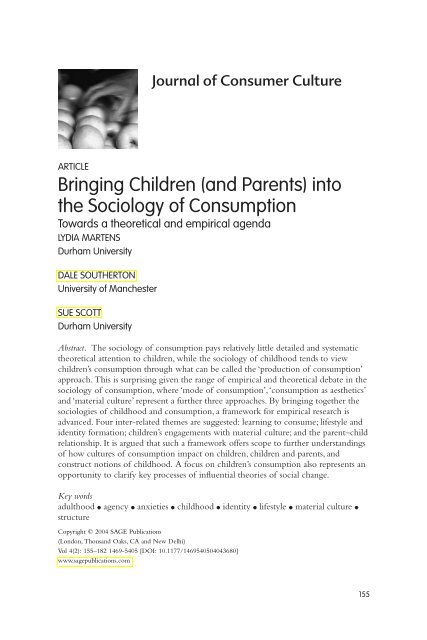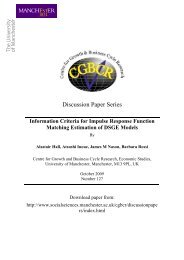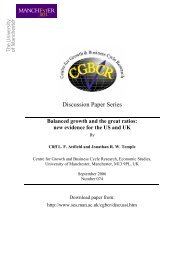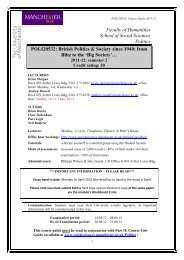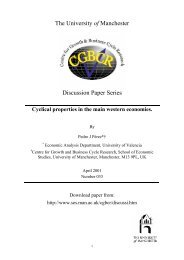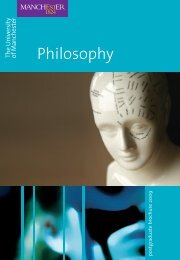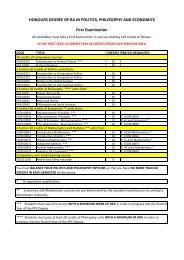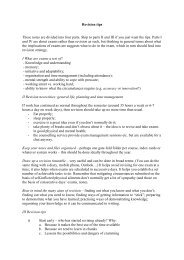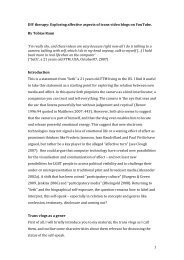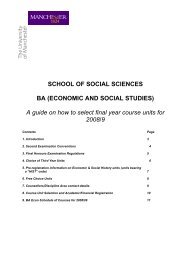Bringing Children (and Parents) into the Sociology of Consumption
Bringing Children (and Parents) into the Sociology of Consumption
Bringing Children (and Parents) into the Sociology of Consumption
You also want an ePaper? Increase the reach of your titles
YUMPU automatically turns print PDFs into web optimized ePapers that Google loves.
ARTICLE<br />
<strong>Bringing</strong> <strong>Children</strong> (<strong>and</strong> <strong>Parents</strong>) <strong>into</strong><br />
<strong>the</strong> <strong>Sociology</strong> <strong>of</strong> <strong>Consumption</strong><br />
Towards a <strong>the</strong>oretical <strong>and</strong> empirical agenda<br />
LYDIA MARTENS<br />
Durham University<br />
DALE SOUTHERTON<br />
University <strong>of</strong> Manchester<br />
SUE SCOTT<br />
Durham University<br />
Abstract. The sociology <strong>of</strong> consumption pays relatively little detailed <strong>and</strong> systematic<br />
<strong>the</strong>oretical attention to children, while <strong>the</strong> sociology <strong>of</strong> childhood tends to view<br />
children’s consumption through what can be called <strong>the</strong> ‘production <strong>of</strong> consumption’<br />
approach. This is surprising given <strong>the</strong> range <strong>of</strong> empirical <strong>and</strong> <strong>the</strong>oretical debate in <strong>the</strong><br />
sociology <strong>of</strong> consumption, where ‘mode <strong>of</strong> consumption’,‘consumption as aes<strong>the</strong>tics’<br />
<strong>and</strong> ‘material culture’ represent a fur<strong>the</strong>r three approaches. By bringing toge<strong>the</strong>r <strong>the</strong><br />
sociologies <strong>of</strong> childhood <strong>and</strong> consumption, a framework for empirical research is<br />
advanced. Four inter-related <strong>the</strong>mes are suggested: learning to consume; lifestyle <strong>and</strong><br />
identity formation; children’s engagements with material culture; <strong>and</strong> <strong>the</strong> parent–child<br />
relationship. It is argued that such a framework <strong>of</strong>fers scope to fur<strong>the</strong>r underst<strong>and</strong>ings<br />
<strong>of</strong> how cultures <strong>of</strong> consumption impact on children, children <strong>and</strong> parents, <strong>and</strong><br />
construct notions <strong>of</strong> childhood. A focus on children’s consumption also represents an<br />
opportunity to clarify key processes <strong>of</strong> influential <strong>the</strong>ories <strong>of</strong> social change.<br />
Key words<br />
adulthood ● agency ● anxieties ● childhood ● identity ● lifestyle ● material culture ●<br />
structure<br />
Copyright © 2004 SAGE Publications<br />
(London, Thous<strong>and</strong> Oaks, CA <strong>and</strong> New Delhi)<br />
Vol 4(2): 155–182 1469-5405 [DOI: 10.1177/1469540504043680]<br />
www.sagepublications.com<br />
Journal <strong>of</strong> Consumer Culture<br />
155
Journal <strong>of</strong> Consumer Culture 4(2)<br />
INTRODUCTION<br />
<strong>Consumption</strong> <strong>and</strong> childhood 1 have each become established as recognized<br />
<strong>and</strong> valued academic projects since <strong>the</strong> 1990s. At <strong>the</strong> same time, childhood<br />
has come to be regarded as increasingly commercialized <strong>and</strong> children are<br />
no longer seen as outsiders to contemporary consumer culture. Yet, so far,<br />
little effort has been made in ei<strong>the</strong>r <strong>the</strong> sociologies <strong>of</strong> childhood or<br />
consumption to <strong>the</strong>orize <strong>the</strong> relationship between <strong>the</strong>m. For instance, in a<br />
major edited collection on <strong>the</strong> sociology <strong>of</strong> childhood, consumption<br />
appears as a mere sub<strong>the</strong>me <strong>of</strong> representations <strong>of</strong> childhood in just one <strong>of</strong><br />
<strong>the</strong> 10 chapters (Hunt <strong>and</strong> Frankenberg, 1997). In this article, we comment<br />
on <strong>the</strong> sociology <strong>of</strong> consumption, <strong>and</strong> here, too, <strong>the</strong> silence when it comes<br />
to examining or commenting upon consumption practices engaged in by,<br />
<strong>and</strong> on behalf <strong>of</strong>, children, is surprising. 2 Given this, it may seem surprising<br />
that <strong>the</strong>re actually exists a wealth <strong>of</strong> literature on children’s confrontations<br />
with material, service <strong>and</strong> popular culture.<br />
Our starting point in this article is to situate this body <strong>of</strong> literature<br />
within <strong>the</strong> sociology <strong>of</strong> consumption <strong>and</strong> <strong>the</strong>n to outline <strong>the</strong> implications<br />
<strong>of</strong> <strong>the</strong> neglect <strong>of</strong> children’s consumption in o<strong>the</strong>r areas <strong>of</strong> that work.<br />
Developments in <strong>the</strong> sociology <strong>of</strong> consumption have been modelled in<br />
different ways (Fea<strong>the</strong>rstone, 1990; Halkier, 2002; Lury, 1996; Warde <strong>and</strong><br />
Martens, 2000), although <strong>the</strong>re is broad consensus about <strong>the</strong> major outlines<br />
<strong>of</strong> <strong>the</strong> three dominant perspectives. The first,‘production <strong>of</strong> consumption’<br />
(Fea<strong>the</strong>rstone, 1990), embraces early work by critical culture <strong>the</strong>orists who<br />
conceptualize consumption through analysis <strong>and</strong> interpretation <strong>of</strong> <strong>the</strong><br />
characteristics <strong>of</strong> <strong>the</strong> sphere <strong>of</strong> production. The second approach draws<br />
attention to <strong>the</strong> ‘mode <strong>of</strong> consumption’ <strong>and</strong> how it comes to represent<br />
distinctions <strong>and</strong> mediate <strong>the</strong> social relationships between different groups.<br />
Finally, what has been called ‘consumption as aes<strong>the</strong>tics’ groups toge<strong>the</strong>r<br />
work by postmodernists such as Baudrillard <strong>and</strong> social <strong>the</strong>orists including<br />
Giddens, Bauman <strong>and</strong> Beck. The latter have approached consumption not<br />
so much from <strong>the</strong> angle <strong>of</strong> aes<strong>the</strong>tics, but ra<strong>the</strong>r conceptualize it as<br />
exemplifying <strong>the</strong> individualizing tendencies <strong>of</strong> modern society.<br />
Recent trends in <strong>the</strong> sociology <strong>of</strong> consumption are perhaps more<br />
difficult to fit <strong>into</strong> one <strong>the</strong>matic/<strong>the</strong>oretical group. Of particular interest<br />
to our concerns are approaches that emphasize ‘ordinary consumption’,<br />
concentrating on routine, conventional <strong>and</strong> repetitive conduct <strong>and</strong> on <strong>the</strong><br />
inconspicuous (Gronow <strong>and</strong> Warde, 2001). In part, such approaches are a<br />
critique <strong>of</strong> <strong>the</strong> sociology <strong>of</strong> consumption’s overemphasis on highly visible<br />
forms <strong>of</strong> consumption, on <strong>the</strong> spectacular <strong>and</strong> on symbolic value ra<strong>the</strong>r<br />
than <strong>the</strong> practical use <strong>of</strong> goods. More significant is <strong>the</strong> insistence on<br />
156
Martens et al. / <strong>Bringing</strong> children <strong>into</strong> consumption<br />
conceptualizing consumption as practice (ra<strong>the</strong>r than, say, purchase or<br />
display, which are but two elements <strong>of</strong> practice). This raises questions about<br />
rules <strong>and</strong> competent conduct in <strong>the</strong> process <strong>of</strong> consuming; about belonging<br />
or ‘fitting in’ to social groups; about <strong>the</strong> production <strong>of</strong> routines; <strong>and</strong><br />
about <strong>the</strong> power dynamics that define <strong>the</strong> relational social values <strong>of</strong><br />
consumption practices (Harvey et al., 2001).<br />
This article has some affinities with perspectives that focus on ordinary<br />
consumption <strong>and</strong> ‘practice’. It is our contention that much work on<br />
children <strong>and</strong> consumption largely falls within <strong>the</strong> ‘production <strong>of</strong> consumption’<br />
approach. As such, analyses <strong>of</strong> <strong>the</strong> practices through which<br />
children <strong>and</strong> <strong>the</strong>ir parents consume are absent. Following a broad review<br />
<strong>of</strong> <strong>the</strong> literature on children <strong>and</strong> consumption, attention is turned to key<br />
perspectives in <strong>the</strong> sociology <strong>of</strong> consumption.Theories <strong>of</strong> consumption as a<br />
means <strong>of</strong> social reproduction <strong>and</strong> class differentiation (Bourdieu,1984;Holt,<br />
1997; Savage, 2000; Warde, 1997), accounts <strong>of</strong> consumption as central to<br />
identity formation through <strong>the</strong> cultivation <strong>of</strong> lifestyle (Bauman,1988;Beck,<br />
1992; Giddens, 1991) <strong>and</strong> analyses <strong>of</strong> engagement with material culture<br />
(Chin, 2001; Kopyt<strong>of</strong>f, 1986; Messner, 2000; Miller, 1987) are discussed.<br />
These <strong>the</strong>ories <strong>of</strong> consumption raise a range <strong>of</strong> important questions about<br />
<strong>the</strong> role <strong>of</strong> consumption in mediating parent–child relationships, how<br />
children learn to consume, consumption <strong>and</strong> social reproduction, <strong>the</strong><br />
dynamics <strong>of</strong> social change <strong>and</strong> <strong>the</strong> creation <strong>of</strong> parental anxieties around<br />
consumption. Moreover, <strong>and</strong> given arguments that children are increasingly<br />
individualized as a result <strong>of</strong> <strong>the</strong>ir acquisition <strong>of</strong> independence at progressively<br />
younger ages (Buchner et al., 1994; Furlong <strong>and</strong> Cartmel, 1997; Hood et al.,<br />
1996), consumption represents a principal mechanism through which individualization<br />
is expressed or suppressed by <strong>the</strong> parental <strong>and</strong> social network<br />
<strong>and</strong> institutional influences that might shape children’s everyday lives. In<br />
conclusion, we suggest that recognition <strong>of</strong> <strong>the</strong>ories concerning <strong>the</strong> ‘mode’<br />
<strong>of</strong>, degrees <strong>of</strong> autonomy in <strong>and</strong> material engagement with consumption<br />
provides <strong>the</strong> framework for an empirical agenda that investigates <strong>the</strong> relationship<br />
between children <strong>and</strong> consumption. A consideration <strong>of</strong> <strong>the</strong>se issues also<br />
<strong>of</strong>fers <strong>the</strong> opportunity for <strong>the</strong>oretical <strong>and</strong> conceptual clarifications in underst<strong>and</strong>ings<br />
<strong>of</strong> consumption, specifically with respect to debates regarding<br />
consumer autonomy, reflexivity <strong>and</strong> structural constraints on social practice.<br />
CHILDREN AND THE PRODUCTION OF CONSUMPTION<br />
Perhaps <strong>the</strong> most straightforward way in which work on children’s<br />
consumption may be categorized is through <strong>the</strong> type <strong>of</strong> children’s goods<br />
or services that feature in <strong>the</strong> discussion. The specific areas <strong>of</strong> media<br />
157
Journal <strong>of</strong> Consumer Culture 4(2)<br />
(Alex<strong>and</strong>er, 1994; Buckingham, 2000; Cook, 2000a; Higonnet, 1998;<br />
Kinder, 1993; Kline, 1993; Postman, 1994) <strong>and</strong> toy culture (Best, 1998;<br />
Cassell <strong>and</strong> Jenkins, 1998; Chin, 1999; Clark <strong>and</strong> Higonnet, 1999; Cook,<br />
2001; Cross, 1998; Hellendoorn <strong>and</strong> Harinck, 1997; Luke, 1994; Martin et<br />
al., 1995; Pennell, 1994; R<strong>and</strong>, 1995; Seiter, 1993; Sutton-Smith, 1986) have<br />
without doubt received most attention, with a less extensive literature on<br />
children’s clothing (Cook, 1995, 1999, 2000b, c; Storm-Mathisen, 2001) <strong>and</strong><br />
food (Charles <strong>and</strong> Kerr, 1988; DeVault, 1991; James, 1982, 1990; Lupton,<br />
1996). These <strong>and</strong> o<strong>the</strong>r materials come from a range <strong>of</strong> academic disciplines,<br />
including anthropology, education, feminism, geography, history,<br />
marketing, media <strong>and</strong> cultural <strong>the</strong>ory, psychology <strong>and</strong> sociology.<br />
Of little surprise is that disciplinary background has a strong influence<br />
on <strong>the</strong> <strong>the</strong>oretical questions examined. Psychologists <strong>and</strong> educationalists<br />
have,for example,worked hard at underst<strong>and</strong>ing children’s consumer socialization<br />
( John, 1999) <strong>and</strong> children’s play <strong>and</strong> toy culture (Kelly-Byrne, 1989;<br />
Sutton-Smith, 1986, 1994). Those in marketing, media <strong>and</strong> cultural studies<br />
have primarily been interested in <strong>the</strong> nature <strong>of</strong> markets for children’s goods<br />
<strong>and</strong> services (Acuff, 1997; Guber <strong>and</strong> Berry, 1993; McNeal, 1992; Steinberg<br />
<strong>and</strong> Kincheloe, 1997) <strong>and</strong> have concerned <strong>the</strong>mselves with market<br />
representations <strong>of</strong> childhood, with gendered identities <strong>and</strong> with children as<br />
economic agents who actively engage in <strong>the</strong> production, distribution <strong>and</strong><br />
consumption <strong>of</strong> material goods (McNeal, 1999; Zelizer, 2002).<br />
A range <strong>of</strong> social consumption relationships have been explored by<br />
researchers. Some focus on peer group communication implicating material<br />
culture (Adler <strong>and</strong> Adler, 1998; Storm-Mathisen, 2001), while o<strong>the</strong>rs<br />
concentrate more on intrafamilial dynamics (Cross, 2002; Foxman et al.,<br />
1989a, b; McKendrick et al., 2000) or a combination <strong>of</strong> <strong>the</strong>se (Evans, 2001;<br />
Kempson et al., 1994; Middleton et al., 1994; Zelizer, 2002). However,<br />
much work on children’s consumption shares an apparently uniform point<br />
<strong>of</strong> departure in that it focuses on <strong>the</strong> relationship between <strong>the</strong> market <strong>and</strong><br />
children to <strong>the</strong> neglect <strong>of</strong> o<strong>the</strong>r pertinent social relationships. An <strong>of</strong>trecurring<br />
<strong>the</strong>sis – that children effectively pester <strong>the</strong>ir parents <strong>into</strong> parting<br />
with <strong>the</strong>ir money when, ra<strong>the</strong>r than if, <strong>the</strong>y succumb to <strong>the</strong> lures <strong>of</strong> <strong>the</strong><br />
market – provides an unacknowledged justification for this focus.<br />
One corollary <strong>of</strong> this is <strong>the</strong> notable lack <strong>of</strong> interest in <strong>the</strong> symbolic<br />
meanings that people, whe<strong>the</strong>r adult or child, create around <strong>the</strong> goods <strong>and</strong><br />
services <strong>the</strong>y consume. Given that we are talking about children’s consumption,<br />
it is surprising how little empirical research has been conducted with<br />
children (Best, 1998; Chin, 1999; Seiter, 1993). There apparently exists a<br />
preference for data being generated from documentary <strong>and</strong> pictorial<br />
158
Martens et al. / <strong>Bringing</strong> children <strong>into</strong> consumption<br />
evidence (Alex<strong>and</strong>er, 1994; Ch<strong>and</strong>ler <strong>and</strong> Griffiths, 2000; Clark <strong>and</strong><br />
Higonnet, 1999; Cook, 1995, 2000c; Cross, 1998; Higonnet, 1998; Luke,<br />
1994) or by a direct reading from toys (Best, 1998; R<strong>and</strong>, 1995; Varney,<br />
1996) ra<strong>the</strong>r than investigating children <strong>the</strong>mselves,whe<strong>the</strong>r by talking with<br />
<strong>the</strong>m, through observation <strong>of</strong> <strong>the</strong>ir negotiations in commercial space<br />
(Bullen <strong>and</strong> Kenway, 2001; Russell <strong>and</strong> Tyler, 2002) or engagement with,<br />
<strong>and</strong> utilization <strong>of</strong>, children’s material culture (Chin, 1999; Messner, 2000)<br />
<strong>and</strong> services (Buckingham, 2000).<br />
Ano<strong>the</strong>r consequence is that children are <strong>of</strong>ten treated as a homogeneous<br />
social group <strong>of</strong> apparently impressionable <strong>and</strong> pressurized individuals<br />
ra<strong>the</strong>r than as diverse in terms <strong>of</strong> age, abilities, sense <strong>of</strong> self/agency<br />
<strong>and</strong> knowledge <strong>of</strong>, <strong>and</strong> experience with, material <strong>and</strong> consumer culture.<br />
Although analyses <strong>of</strong> situations in which young children are present have<br />
increased in recent years (Harden, 2000; Scott et al., 2000), few researchers<br />
address contexts <strong>of</strong> consumption (for exceptions, see Cook, 1995, 2000b;<br />
McKendrick et al., 2000; Sutton-Smith, 1986). Consequently, accounts <strong>of</strong><br />
children’s consumption tend to focus on ‘older children’,with limited attention<br />
paid to social context; indeed, a great deal <strong>of</strong> consumption takes place<br />
on behalf <strong>of</strong> children still to be born <strong>and</strong> babies <strong>and</strong> toddlers who have not<br />
yet developed a sense <strong>of</strong> consumer culture. This is necessarily consumption<br />
engaged in by adults (parents, family, friends, colleagues <strong>and</strong> neighbours) on<br />
behalf <strong>of</strong> children where <strong>the</strong> type <strong>of</strong> questions that ought to interest <strong>the</strong><br />
researcher should be distinctly different from those appropriate in households<br />
with older children.<br />
As must be clear from <strong>the</strong> above, much <strong>of</strong> what we currently recognize<br />
as scholarly work on children’s consumption shares some <strong>of</strong> <strong>the</strong> main<br />
characteristics <strong>of</strong> <strong>the</strong> approach known as <strong>the</strong> ‘production <strong>of</strong> consumption’<br />
<strong>and</strong>, thus, reproduces some <strong>of</strong> <strong>the</strong> fears that have beset this approach.<br />
Importantly, we find in this work a concentration on <strong>the</strong> sphere <strong>of</strong> production,<br />
distribution <strong>and</strong> products (i.e. toys) to <strong>the</strong> exclusion <strong>of</strong> users (i.e.<br />
children <strong>and</strong> parents). It utilizes a narrow definition <strong>of</strong> consumption that<br />
concentrates on <strong>the</strong> market <strong>and</strong> does not pay attention to o<strong>the</strong>r modes <strong>of</strong><br />
provision such as <strong>the</strong> domestic or communal modes (Harvey et al., 2001).<br />
In addition, <strong>and</strong> as suggested above, empirical research shuns an interpretation<br />
<strong>of</strong> <strong>the</strong> consumer cultures experienced by children or adults, whe<strong>the</strong>r<br />
in <strong>the</strong> household context or not (Best, 1998; Buckingham, 2000).<br />
Moreover, <strong>the</strong> construction <strong>of</strong> <strong>the</strong> child consumer as easily manipulated<br />
<strong>and</strong> in need <strong>of</strong> guidance mirrors <strong>the</strong> patronizing tone adopted in <strong>the</strong><br />
construction <strong>of</strong> <strong>the</strong> adult consumer in critical thought. Lastly, as is <strong>the</strong> case<br />
with o<strong>the</strong>r ‘production <strong>of</strong> consumption’ work (for example, Finkelstein,<br />
159
Journal <strong>of</strong> Consumer Culture 4(2)<br />
1989;Wood, 1995), consumer behaviour is <strong>of</strong>ten read <strong>of</strong>f from production<br />
trends – a feature that has been criticized for resulting in inaccurate readings<br />
<strong>of</strong> <strong>the</strong> reasons why consumers engage with goods <strong>and</strong> services in <strong>the</strong><br />
manner <strong>the</strong>y do (Martens <strong>and</strong> Warde, 1997; Warde <strong>and</strong> Martens, 2000).<br />
What we find here is a characterization <strong>of</strong> <strong>the</strong> relationship between production<br />
<strong>and</strong> consumption in which production simply stipulates consumer<br />
behaviour.<br />
The latter is all too evident in <strong>the</strong> so-called ‘effects research’, which<br />
attempts to identify <strong>and</strong> establish <strong>the</strong> negative impact <strong>of</strong> <strong>the</strong> products <strong>of</strong><br />
production on <strong>the</strong> consumers <strong>of</strong> those products (i.e. children). <strong>Children</strong>’s<br />
playthings have, for example, primarily been conceptualized as ‘reproducing<br />
society’s troubling features’ <strong>and</strong> concern has centred on ‘hazardous toys, war<br />
toys, sexist toys, or racist toys’ (Best, 1998: 197). Kline suggests that <strong>the</strong><br />
problem with effects research lies in <strong>the</strong> difficulty <strong>of</strong> pinpointing in a<br />
convincing manner any significant ‘effects’ <strong>of</strong> cultural goods upon children.<br />
Yet he appears to take <strong>the</strong> same route himself by <strong>of</strong>fering an apparently<br />
sophisticated argument about producers grasping children’s imaginative<br />
worlds <strong>and</strong> catering for <strong>the</strong>m to <strong>the</strong> detriment <strong>of</strong> children developing <strong>the</strong>ir<br />
own imaginative capabilities (Kline, 1988, 1993). 3<br />
More recently, this ‘simple’ effects research has been accompanied by<br />
commentaries that centre on <strong>the</strong> textual messages encoded in, <strong>and</strong><br />
embodied by, goods <strong>and</strong> services. Some <strong>of</strong> this contains a similar reasoning<br />
<strong>and</strong> lack <strong>of</strong> attention to <strong>the</strong> contribution consumers make to circulating<br />
meaning systems as found in <strong>the</strong> above example. Carmen Luke, for<br />
example, suggests that ‘how children negotiate <strong>and</strong> experience <strong>the</strong> messages<br />
<strong>of</strong> popular cultural texts is crucial to any underst<strong>and</strong>ing <strong>of</strong> <strong>the</strong> relationship<br />
among cultural texts, artefacts, social subjects <strong>and</strong> practices’ (1994: 289;<br />
emphasis added). Even so, <strong>and</strong> like most <strong>of</strong> her predecessors, her research<br />
exhibits a preference for ‘<strong>the</strong> larger discourses – <strong>the</strong> rhetorical constructs –<br />
<strong>of</strong> childhood <strong>and</strong> parenthood in popular cultural representations’ (1994:<br />
289). In <strong>the</strong> ensuing discussion, Luke gives <strong>the</strong> impression that listening to<br />
children <strong>and</strong> parents may not reveal much at all. After arguing that <strong>the</strong><br />
‘public sites <strong>and</strong> texts’ <strong>of</strong> popular culture ‘encode constructs <strong>of</strong> childhood<br />
<strong>and</strong> parenthood, <strong>and</strong> act as powerful public pedagogies in <strong>the</strong> production<br />
<strong>of</strong> social identities <strong>of</strong> <strong>the</strong> “child”,“family”,“gender” or “race”’, she progressively<br />
moves on to a conceptual terrain that posits children as inevitably<br />
<strong>and</strong> invariably enveloped by popular culture – an ‘intertextual universe, a<br />
network <strong>of</strong> desire’ that is experienced as natural <strong>and</strong> taken for granted<br />
(1994: 291) <strong>and</strong> that predates actual children <strong>and</strong> effectively frames<br />
children’s meaning systems. 4<br />
160
Martens et al. / <strong>Bringing</strong> children <strong>into</strong> consumption<br />
To date, dissenting voices have been rare in what seems like a continuous<br />
flow <strong>of</strong> critique about children’s consumer culture. Best (1998),<br />
Buckingham (2000), Seiter (1993) <strong>and</strong> Zelizer (2002) all address <strong>the</strong> persistent<br />
dominance <strong>of</strong> negative interpretations <strong>of</strong> children’s consumer culture. 5<br />
All agree that <strong>the</strong> way forward is in <strong>the</strong> examination <strong>of</strong> consumers’ meaning<br />
systems, with Best, in particular, arguing that sociologists should do what<br />
<strong>the</strong>y do best, which is to examine where <strong>the</strong> action is:<br />
We should be fully aware that studying material culture means<br />
studying people – not objects. We should be watching children<br />
playing with toys, talking to children about <strong>the</strong>ir play, or – as I<br />
have tried to do here – at least examining how claimsmakers<br />
turn toys <strong>into</strong> social problems, ra<strong>the</strong>r than trying to read <strong>the</strong><br />
meanings embedded in <strong>the</strong>se, or any o<strong>the</strong>r, cultural artefacts.<br />
Studying people is something we know how to do well. Culture<br />
emerges in actions, not artefacts, <strong>and</strong> we ought to be where <strong>the</strong><br />
action is. (1998: 208)<br />
However, despite such agenda setting, few have put <strong>the</strong> advice <strong>into</strong><br />
practice. We agree that, as commercial endeavours continue to exp<strong>and</strong> <strong>and</strong><br />
impact on consumer practice, elaboration <strong>of</strong> our knowledge about <strong>the</strong><br />
production side <strong>of</strong> children’s consumer culture is necessary. It could be said<br />
that this is <strong>the</strong> <strong>the</strong>me <strong>of</strong> Dan Cook’s work. In his studies <strong>of</strong> <strong>the</strong> children’s<br />
clothing industry, for example, he explicates how this market has historically<br />
utilized medical psychological <strong>the</strong>ories <strong>of</strong> child development as a<br />
means <strong>of</strong> fragmenting <strong>the</strong> market for children’s goods, producing childhood<br />
categories such as ‘<strong>the</strong> toddler’ along <strong>the</strong> way (Cook, 1995, 1999, 2000b).<br />
However, <strong>and</strong> ra<strong>the</strong>r than transgressing <strong>into</strong> claims about <strong>the</strong> impact <strong>of</strong><br />
consumer culture on children, <strong>the</strong> part played by consumers (whe<strong>the</strong>r<br />
children, parents or related network members) as individuals <strong>and</strong> as<br />
members <strong>of</strong> interrelated social groups appears to have been missed in<br />
empirical <strong>and</strong> <strong>the</strong>oretical accounts <strong>of</strong> children’s consumption. Despite all<br />
<strong>the</strong> valuable insights gained by a focus on <strong>the</strong> ‘production’ <strong>of</strong> children’s<br />
consumption, relatively little is known about how children engage in practices<br />
<strong>of</strong> consumption or what <strong>the</strong> significance <strong>of</strong> this is to <strong>the</strong>ir everyday<br />
lives <strong>and</strong> broader issues <strong>of</strong> social organization.<br />
The sociology <strong>of</strong> consumption has seen exactly such a shift towards<br />
consumers <strong>and</strong> <strong>the</strong>ir practices <strong>and</strong>, ironically, recent critiques have highlighted<br />
how this has led to oversights regarding <strong>the</strong> significance <strong>of</strong> ‘production’<br />
in <strong>the</strong> configuration <strong>of</strong> consumption (Fine, 2002; Harvey et al., 2001).<br />
161
Journal <strong>of</strong> Consumer Culture 4(2)<br />
However, this shift has led to different sets <strong>of</strong> questions being asked about<br />
<strong>the</strong> role <strong>and</strong> purpose <strong>of</strong> consumption in contemporary society. For<br />
example, about how consumption mediates social relations, whe<strong>the</strong>r it<br />
represents structural inequalities <strong>and</strong> how it connects with, <strong>and</strong> acts to<br />
sustain, cultural ideologies. O<strong>the</strong>r approaches have paid attention to<br />
consumption <strong>and</strong> identity formation in response to <strong>the</strong> broader social<br />
changes <strong>of</strong> globalization <strong>and</strong> economic restructuring; to <strong>the</strong> sites <strong>of</strong><br />
consumption as places <strong>of</strong> desire, pleasure <strong>and</strong> escapism; <strong>and</strong> questions are<br />
asked about how people engage in material culture <strong>and</strong> make <strong>the</strong> world <strong>of</strong><br />
objects subjectively meaningful. This is not to suggest that existing studies<br />
<strong>of</strong> children <strong>and</strong> consumption do not consider some <strong>of</strong> <strong>the</strong>se issues or<br />
questions, but to suggest that <strong>the</strong> weight <strong>of</strong> research endeavour fits within<br />
one particular approach to consumption. Consequently, <strong>the</strong>re remains<br />
significant scope for empirical <strong>and</strong> <strong>the</strong>oretical applications <strong>of</strong> insights from<br />
<strong>the</strong> sociology <strong>of</strong> consumption to <strong>the</strong> study <strong>of</strong> <strong>the</strong> relationship between<br />
children <strong>and</strong> consumption.<br />
CONSUMPTION AND THE INVISIBILITY OF CHILDREN<br />
<strong>Children</strong> are largely invisible in <strong>the</strong>ories <strong>of</strong> consumption. This is surprising<br />
given <strong>the</strong> impact <strong>the</strong>y have on lifestyle, on issues connected to social<br />
reproduction <strong>and</strong> in terms <strong>of</strong> <strong>the</strong> emotional <strong>and</strong> anxiety-laden relationship<br />
between childhood <strong>and</strong> consumer culture. This section explores three key<br />
approaches to consumption – ‘mode <strong>of</strong> consumption’ <strong>and</strong> learning to<br />
consume; lifestyle <strong>and</strong> identity formation; <strong>and</strong> material culture – in order<br />
to sketch a framework for empirical inquiry <strong>and</strong> <strong>the</strong>oretical development<br />
in <strong>the</strong> underst<strong>and</strong>ing <strong>of</strong> its relationship with children <strong>and</strong> parents. While<br />
we do not have scope here to discuss all <strong>the</strong> <strong>the</strong>ories that fall within <strong>and</strong><br />
between <strong>the</strong>se three approaches, this section also explains how a consideration<br />
<strong>of</strong> children <strong>and</strong> consumption would provide instructive insights <strong>into</strong><br />
debates that divide this field <strong>of</strong> sociological enquiry – particularly relating<br />
to consumer agency <strong>and</strong> social structure – by identifying <strong>the</strong> most prominent<br />
ones.<br />
‘Mode <strong>of</strong> consumption’, social reproduction <strong>and</strong> learning to<br />
consume<br />
In recent years, <strong>and</strong> particularly in <strong>the</strong> light <strong>of</strong> debates regarding modernity<br />
<strong>and</strong> postmodernity, attention has turned to <strong>the</strong> ‘mode <strong>of</strong> consumption’,<br />
which Fea<strong>the</strong>rstone summarizes as ‘<strong>the</strong> way that goods are variably used to<br />
create distinctions <strong>and</strong> reinforce social relationships’ (1991: 5). Of particular<br />
162
Martens et al. / <strong>Bringing</strong> children <strong>into</strong> consumption<br />
significance is <strong>the</strong> work <strong>of</strong> Pierre Bourdieu (1984), who sees consumption<br />
as a process <strong>of</strong> reproducing dispositions that constitute differential tastes <strong>and</strong><br />
emanate from <strong>the</strong> pursuit <strong>of</strong> <strong>the</strong> conduct <strong>of</strong> a life that is subjectively acceptable<br />
in <strong>the</strong> context <strong>of</strong> objectively given circumstances. These objective<br />
circumstances relate to class-based constraints associated with an individual’s<br />
material wealth (economic), types <strong>of</strong> knowledge (cultural) <strong>and</strong> access to<br />
networks (social), all acting as resources (accumulated to form capital) that<br />
are deployed when judging taste in <strong>the</strong> pursuit <strong>of</strong> social practice. While<br />
amounts <strong>of</strong> capital constrain action in <strong>the</strong> form <strong>of</strong> individual consumption<br />
orientations, strategies <strong>of</strong> distinction employ shared tastes in consumption<br />
to mark, <strong>and</strong> make subjectively meaningful, class-based social boundaries, a<br />
process in which taste is understood <strong>and</strong> judged on <strong>the</strong> basis <strong>of</strong> identifications<br />
with ‘us’ <strong>and</strong> classifications <strong>of</strong> ‘<strong>the</strong>m’ (Sou<strong>the</strong>rton, 2002). Consequently,<br />
class shapes consumption orientations while consumption is<br />
representative <strong>of</strong>, <strong>and</strong> acts to reproduce, class-based social relations.<br />
These processes are best captured in Bourdieu’s somewhat nebulous<br />
concept <strong>of</strong> ‘habitus’. Habitus is ‘an acquired system <strong>of</strong> generative schemes<br />
objectively adjusted to <strong>the</strong> particular conditions in which it is constituted’<br />
(Jenkins,1992: 74). It is both a‘structured structure’<strong>and</strong> a‘structuring structure’.<br />
It is structured in that it is <strong>the</strong> principal mechanism for <strong>the</strong> division<br />
<strong>of</strong> social groupings according to class-based dispositions. It is a ‘structuring<br />
structure’ because it organizes agents’ perceptions <strong>and</strong> practices: habitus is<br />
both <strong>the</strong> producer <strong>and</strong> ‘<strong>the</strong> product <strong>of</strong> internalisation <strong>of</strong> <strong>the</strong> division <strong>into</strong><br />
social classes’ (Bourdieu, 1984: 170). Attempting to overcome <strong>the</strong> classic<br />
structure agency antinomy,habitus can be regarded as dynamic to <strong>the</strong> extent<br />
that it redefines itself according to new experiences as a structured structure.<br />
Yet, any change will not be dramatic, as <strong>the</strong> structuring principles tend<br />
to constrain any reorientation <strong>of</strong> habitus due to <strong>the</strong> internalized nature <strong>of</strong><br />
dispositions.<br />
Curiously, given this emphasis on habitus as ‘learned’ <strong>and</strong> internalized,<br />
no application <strong>of</strong> Bourdieu’s <strong>the</strong>ory has been made with respect to<br />
children’s consumption; ra<strong>the</strong>r, <strong>the</strong> intergenerational transfer <strong>of</strong> capital <strong>and</strong><br />
internalization <strong>of</strong> habitus are assumed to occur through conceptually vague<br />
processes <strong>of</strong> socialization. There are, however, many reasons why <strong>the</strong>ories<br />
<strong>of</strong> consumption as a mechanism <strong>of</strong> social reproduction would benefit from<br />
a consideration <strong>of</strong> children – not least because <strong>the</strong> parent–child relationship<br />
must take centre stage in accounts <strong>of</strong> why children consume in <strong>the</strong><br />
way that <strong>the</strong>y do. The key issues are how capital is transferred between<br />
generations <strong>and</strong> through what processes <strong>the</strong> habitus becomes internalized.<br />
Connected are questions regarding how <strong>and</strong> from whom/where children<br />
163
Journal <strong>of</strong> Consumer Culture 4(2)<br />
learn to consume; how skills related to competent practice, cultural values<br />
<strong>and</strong> <strong>the</strong> formation <strong>of</strong> taste are transmitted between generations; 6 how ideological<br />
notions <strong>of</strong> consumer autonomy <strong>and</strong> citizenship might be generated<br />
in children’s consumption; <strong>and</strong> what an application <strong>of</strong> a Bourdieusian<br />
approach might reveal about <strong>the</strong> role that consumption plays in <strong>the</strong> social<br />
construction <strong>of</strong> ‘childhood’ <strong>and</strong> ‘adulthood’.<br />
Before addressing <strong>the</strong>se specific issues, two related observations regarding<br />
interpretations <strong>of</strong> children’s consumption are worth noting. Notions <strong>of</strong><br />
‘peer group pressure’ suggest that children are particularly vulnerable to <strong>the</strong><br />
need to gain acceptance <strong>and</strong> belong to social groups <strong>and</strong>, thus, use<br />
consumption to gain recognition within <strong>the</strong>ir social networks <strong>and</strong> to<br />
distinguish <strong>the</strong>mselves from o<strong>the</strong>r groups <strong>of</strong> children (such as ‘geeks’ or <strong>the</strong><br />
‘in crowd’; Storm-Mathisen, 2001). 7 Despite <strong>the</strong> intuitive plausibility <strong>of</strong><br />
children using consumption for <strong>the</strong> purposes <strong>of</strong> distinction, it is important<br />
that underst<strong>and</strong>ings <strong>of</strong> ‘adult’ consumption are not simply imposed on <strong>the</strong>m<br />
(Zelizer, 2002). The logic <strong>of</strong> Bourdieusian accounts would suggest that<br />
children’s distinctions are class based. Alternatively, distinctions might relate<br />
more to interpretations <strong>of</strong> age, with ‘maturity’ or ‘childishness’ counting as<br />
bases for distinction (McKendrick et al., 2000).<br />
The second observation is that distinction through children may well<br />
be important for parents. The idea that children reflect <strong>the</strong>ir parents’<br />
material <strong>and</strong> social status might be a prosaic point, but it does highlight <strong>the</strong><br />
relationality between parents <strong>and</strong> children when it comes to ‘modes <strong>of</strong><br />
consumption’. <strong>Children</strong> can act as symbolic representations <strong>of</strong> <strong>the</strong>ir parents’<br />
cultural orientations <strong>and</strong> attitudes; indeed, Bourdieu’s (1999) ethnographic<br />
accounts <strong>of</strong> <strong>the</strong> French working class detail fa<strong>the</strong>rs’ hopes <strong>and</strong> expectations<br />
that <strong>the</strong>ir children would inherit <strong>the</strong>ir cultural orientations <strong>and</strong> that <strong>the</strong>ir<br />
children’s acceptance reflected <strong>and</strong> displayed <strong>the</strong> legitimacy <strong>and</strong> merit <strong>of</strong><br />
such orientations. This is not to say that children are mere extensions <strong>of</strong><br />
<strong>the</strong>ir parents because <strong>the</strong> negotiations that take place between <strong>the</strong>m regarding<br />
consumption <strong>and</strong> <strong>the</strong> boundaries <strong>of</strong> acceptable behaviour indicate that<br />
children have at least some agency in familial relationships (Scott et al.,<br />
2000). Yet, presumably it is precisely through <strong>the</strong> social <strong>and</strong> symbolic status<br />
that parents invest in <strong>the</strong>ir children that Bourdieu’s social reproduction <strong>of</strong><br />
habitus must take place. To follow his logic, parents’ habitus (as constrained<br />
by <strong>the</strong>ir capital) will determine <strong>the</strong> cultural values employed to raise <strong>the</strong>ir<br />
children, <strong>and</strong> <strong>the</strong> internalization <strong>of</strong> those values will act as representative <strong>of</strong><br />
<strong>the</strong>ir parents’ habitus while, at <strong>the</strong> same time, shaping <strong>the</strong>ir own. However,<br />
given that children resist parental control <strong>and</strong> engage in ‘negotiation’regarding<br />
<strong>the</strong> boundaries <strong>of</strong> accepted (ra<strong>the</strong>r than acceptable) behaviour (Zelizer,<br />
164
Martens et al. / <strong>Bringing</strong> children <strong>into</strong> consumption<br />
2002), significant questions emerge about how <strong>the</strong> habitus <strong>of</strong> children is<br />
formed, how <strong>the</strong> habitus <strong>of</strong> one generation is interpreted <strong>and</strong> enacted in<br />
<strong>the</strong> contexts presented to a different generation <strong>of</strong> actors <strong>and</strong> what impact<br />
children might have on <strong>the</strong>ir parents’ habitus.<br />
Both observations highlight that Bourdieusian analyses <strong>of</strong> adult<br />
consumption cannot be imposed directly onto children’s consumption,<br />
even if processes <strong>of</strong> distinction have captured popular underst<strong>and</strong>ings <strong>of</strong><br />
playground social relations. In addition to underlining <strong>the</strong> need to explore<br />
empirically such <strong>the</strong>oretical reasoning within <strong>the</strong> world <strong>of</strong> children’s<br />
consumption, <strong>the</strong>se observations also reveal significant ‘weak spots’ in <strong>the</strong><br />
core mechanisms <strong>of</strong> social reproduction that <strong>the</strong>se <strong>the</strong>ories pr<strong>of</strong>fer. If <strong>the</strong><br />
internalization <strong>of</strong> habitus relates to <strong>the</strong> learning <strong>of</strong> cultural values, how to<br />
consume <strong>and</strong> what is competent social conduct, <strong>and</strong> if habitus is structured<br />
according to <strong>the</strong> objective constraints <strong>of</strong> capital, <strong>the</strong>n it is in <strong>the</strong> external<br />
social conditions (such as <strong>the</strong> influences <strong>of</strong> school <strong>and</strong> social networks) <strong>and</strong><br />
<strong>the</strong> transfer <strong>of</strong> capital (especially cultural) between parents <strong>and</strong> children that<br />
<strong>the</strong> role <strong>of</strong> consumption in social reproduction will be revealed.<br />
The principal means <strong>of</strong> intergenerational transfers <strong>of</strong> capital are<br />
assumed to centre on education (see Allat, 1993; Bernstein, 1971; Bourdieu<br />
<strong>and</strong> Passeron, 1977) <strong>and</strong> <strong>the</strong> utility <strong>of</strong> networks as a means <strong>of</strong> access to institutions<br />
(Coleman, 1988; Portes, 1998). Such formal mechanisms are undeniably<br />
important in social reproduction. However, <strong>the</strong> subtleties <strong>of</strong> <strong>the</strong><br />
habitus <strong>and</strong> tacit differences <strong>of</strong> orientation that relate to cultural <strong>and</strong> social<br />
capital imply that much ‘capital transfer’ takes place beyond such formal<br />
mechanisms. For example, empirical accounts suggest that <strong>the</strong> personal<br />
characteristics associated with different volumes <strong>of</strong> cultural capital are<br />
exhibited through different forms <strong>of</strong> competence associated with engagement<br />
in cultural practice (Warde et al., 1999). Such studies reveal schemas<br />
<strong>of</strong> cultural orientations, which correlate with group positions in social<br />
space, as measured in terms <strong>of</strong> <strong>the</strong> formal indicators <strong>of</strong> cultural capital (for<br />
example, educational attainment <strong>and</strong> occupational status). Custom versus<br />
novelty (Warde, 1997), self-actualization <strong>and</strong> cosmopolitanism (Lamont,<br />
1992) <strong>and</strong> object versus subject unity (Sou<strong>the</strong>rton, 2001) are examples <strong>of</strong><br />
such orientations. All represent different ways <strong>of</strong> engaging in consumption<br />
based on cultural interpretations <strong>of</strong> <strong>the</strong> value <strong>of</strong> specific consumption practices.<br />
Whe<strong>the</strong>r children exhibit a preference for custom or novelty in <strong>the</strong>ir<br />
food tastes, whe<strong>the</strong>r <strong>the</strong>y describe <strong>the</strong> material organization <strong>of</strong> <strong>the</strong>ir<br />
bedroom through narratives <strong>of</strong> biography (subject unity) or <strong>the</strong> formal stylistic<br />
complementarity <strong>of</strong> objects (object unity; Lincolm, 2001) or employ<br />
o<strong>the</strong>r (non-adult) bases <strong>of</strong> cultural interpretation is an important question<br />
165
Journal <strong>of</strong> Consumer Culture 4(2)<br />
that would prove instructive as regards <strong>the</strong> social formation <strong>of</strong> different<br />
‘modes’ <strong>of</strong> engaging in consumption. 8<br />
<strong>Parents</strong> clearly represent a young child’s most significant influence<br />
when acquiring such orientations. They not only act as gatekeepers regarding<br />
what can be consumed, but also actively engage in cultivating ways <strong>of</strong><br />
consuming. For example, how parents deal with children’s pocket money<br />
or saving to purchase desired goods <strong>and</strong> how <strong>the</strong> selection <strong>of</strong> goods (say,<br />
Christmas presents or clo<strong>the</strong>s) is managed, will hold significant implications<br />
for how children develop an everyday underst<strong>and</strong>ing <strong>of</strong> <strong>the</strong> processes <strong>of</strong><br />
shopping, purchase <strong>and</strong> <strong>the</strong> consumption <strong>of</strong> goods.<br />
But parents are not <strong>the</strong> only actors important in such processes <strong>and</strong><br />
<strong>the</strong>ir significance is likely to decline as children grow older. Networks <strong>of</strong><br />
‘o<strong>the</strong>r’ adults, especially kin, will also play a role in <strong>the</strong> types <strong>of</strong> goods<br />
consumed, as will institutional settings such as schools. It is here that <strong>the</strong><br />
process <strong>of</strong> intergenerational cultural capital ‘transfer’ becomes complicated<br />
<strong>and</strong> <strong>the</strong> importance <strong>of</strong> ‘social capital’ highlighted. The influence <strong>of</strong> media<br />
<strong>and</strong> advertising also becomes more salient for older children, for it is <strong>the</strong><br />
capacity <strong>of</strong> <strong>the</strong> media to impact on which goods <strong>and</strong> services are ‘best’ for<br />
<strong>the</strong> forging <strong>of</strong> social bonds <strong>and</strong> group acceptance (<strong>and</strong>, thus, forming social<br />
networks) to which children appear susceptible (Acuff, 1997; Adler <strong>and</strong><br />
Adler, 1998; McNeal, 1992). At stake is how, <strong>and</strong> <strong>the</strong> degree to which, influences<br />
external to <strong>the</strong> parent–child relationship shape cultural orientations.<br />
Questions regarding which combinations <strong>of</strong> capital are most important are<br />
also raised. For example, parents provide economic capital (which may<br />
prove critical in gaining access to social networks), but, as children grow<br />
older, it may well be <strong>the</strong>ir social capital (<strong>the</strong>ir friends, family, parents’ friends<br />
<strong>and</strong> institutional contacts such as schools) that most influences <strong>the</strong>ir<br />
consumption orientations. In such a case, how cultural capital is accumulated<br />
is not simply a process <strong>of</strong> transfer between parents <strong>and</strong> children, but<br />
between a host <strong>of</strong> social networks <strong>and</strong> institutional relationships. 9 In this<br />
respect, children’s consumption relates to sets <strong>of</strong> complex interrelationships,<br />
only some <strong>of</strong> which can be associated with mechanisms <strong>of</strong> familial distinction.<br />
Equally intriguing in relation to <strong>the</strong> issue <strong>of</strong> learning to ‘consume’ is<br />
how a sense <strong>of</strong> competent conduct in practices <strong>of</strong> consumption is acquired<br />
<strong>and</strong> negotiated. In some respects, generic norms <strong>of</strong> consumption exist (for<br />
example, gift giving <strong>and</strong> <strong>the</strong> fact that you have to purchase most goods<br />
using money). However, <strong>and</strong> as Lamont (1992) <strong>and</strong> Sou<strong>the</strong>rton (2001)<br />
detail, in many o<strong>the</strong>r cases what counts as competent conduct varies significantly<br />
between social groups <strong>and</strong> represents different interpretations <strong>of</strong><br />
166
Martens et al. / <strong>Bringing</strong> children <strong>into</strong> consumption<br />
cultural values <strong>and</strong> tastes; 10 indeed, given that taste <strong>and</strong> cultural values are<br />
dynamic, as highlighted by generational differences, how children acquire<br />
senses <strong>of</strong> competent conduct <strong>of</strong>fers insights <strong>into</strong> broader processes <strong>of</strong> social<br />
change. For, if children learn competence in consumption through <strong>the</strong>ir<br />
parents, social networks <strong>and</strong> institutional settings, <strong>the</strong>n it follows that when<br />
<strong>the</strong>se children reach adulthood, <strong>the</strong> diversification <strong>of</strong> those influences (say,<br />
in terms <strong>of</strong> class, gender <strong>and</strong> ethnicity) might lead both to greater plurality<br />
<strong>of</strong> consumption <strong>and</strong> increased confusion or anxiety regarding what<br />
precisely is <strong>the</strong> appropriate way <strong>of</strong> consuming in different cultural contexts<br />
(which is precisely <strong>the</strong> prognosis <strong>of</strong> many late modern <strong>and</strong> postmodern<br />
<strong>the</strong>ories <strong>of</strong> consumption <strong>and</strong> lifestyle).<br />
Learning to consume also holds implications for <strong>the</strong> social construction<br />
<strong>of</strong> consumption <strong>and</strong> <strong>the</strong> consumer. As Buckingham (2000) explains,<br />
<strong>the</strong> contemporary consumer has come to take on many <strong>of</strong> <strong>the</strong> ideological<br />
roles fulfilled by ‘<strong>the</strong> citizen’. A central ideological feature <strong>of</strong> ‘<strong>the</strong> consumer’<br />
is that <strong>the</strong>y exercise autonomy in <strong>the</strong>ir consumption choices. How parents<br />
deal with issues such as pocket money, saving, expressions <strong>of</strong> choice for gifts<br />
or clo<strong>the</strong>s all point to processes through which ideologies <strong>of</strong> autonomous<br />
consumer choice are constructed. <strong>Consumption</strong> is also implicated in <strong>the</strong><br />
social construction <strong>of</strong> o<strong>the</strong>r discursive categories, particularly adulthood<br />
<strong>and</strong> childhood. For example, Davies et al. (2002) demonstrate how<br />
children’s media tastes are represented as vulgar <strong>and</strong> crude in contrast to<br />
<strong>the</strong> ‘sophisticated’ <strong>and</strong> ‘refined’ tastes <strong>of</strong> adults. Such classifications <strong>of</strong> taste<br />
play a critical role in maintaining <strong>the</strong> boundaries <strong>of</strong> <strong>the</strong> categories ‘adult’<br />
<strong>and</strong> ‘child’. Consequently, an empirical focus on how children learn to<br />
consume <strong>of</strong>fers fundamental insights <strong>into</strong> <strong>the</strong> reproduction <strong>of</strong> structural<br />
differences <strong>and</strong> social change more broadly, <strong>and</strong> <strong>the</strong> social construction <strong>of</strong><br />
key ideological figures (‘<strong>the</strong> consumer’) <strong>and</strong> discursive categories (‘adulthood’<br />
<strong>and</strong> ‘childhood’) in contemporary society.<br />
<strong>Consumption</strong>, lifestyle <strong>and</strong> identity formation<br />
Bourdieusian approaches permit agency in consumption only within <strong>the</strong><br />
constraints <strong>of</strong> traditional (modern) social structures. It is, however, debatable<br />
whe<strong>the</strong>r consumption is as rigidly constrained as such <strong>the</strong>ories allow,<br />
not least because accounts like that <strong>of</strong> Bourdieu depend on clearly divisible<br />
stratifications <strong>of</strong> social classification. For Fea<strong>the</strong>rstone (1991), <strong>the</strong> proliferation<br />
<strong>of</strong> commodities in consumer culture has made this process <strong>of</strong> classification<br />
less straightforward because <strong>of</strong> <strong>the</strong> growing difficulty <strong>of</strong> reading<br />
displays <strong>of</strong> goods as signs <strong>of</strong> social status. Processes such as globalization,<br />
economic restructuring <strong>and</strong> shifts from Fordist to post-Fordist modes <strong>of</strong><br />
167
Journal <strong>of</strong> Consumer Culture 4(2)<br />
production are highlighted as key mechanisms that mean that identities are<br />
no longer unproblematically assigned to individuals or social groups; ra<strong>the</strong>r,<br />
through consumption, individuals have greater capacity to decide ‘who <strong>the</strong>y<br />
want to be’ <strong>and</strong> narrate <strong>the</strong>ir identity by appropriating styles <strong>of</strong> consumption.<br />
The proliferation <strong>of</strong> goods <strong>and</strong> styles available within global markets<br />
means that those with similar economic resources are presented with a<br />
range <strong>of</strong> lifestyles from which to choose. <strong>Consumption</strong> becomes not simply<br />
a choice about goods <strong>and</strong> services, but a choice about a style <strong>of</strong> life, about<br />
who we are <strong>and</strong> how we wish to be perceived by o<strong>the</strong>rs in particular social<br />
settings (Bauman, 1988; Fea<strong>the</strong>rstone, 1991; Giddens, 1991).<br />
In this perspective on late or postmodern society, <strong>the</strong> ‘adult’ world <strong>of</strong><br />
consumption is presented as one <strong>of</strong> ‘freedom’ (Bauman, 1988). However,<br />
this freedom is precarious, individuals have a responsibility to create <strong>the</strong>ir<br />
own identity <strong>and</strong> <strong>the</strong>refore have ‘no choice but to consume’(Giddens,1991:<br />
81). Lacking <strong>the</strong> normative bonds provided by collective identities (such as<br />
class <strong>and</strong> family) <strong>and</strong> <strong>the</strong> corresponding certainties attached to senses <strong>of</strong><br />
belonging (Warde, 1994), anxiety is generated concerning making correct<br />
decisions. The market provides guidance through advertising, <strong>the</strong> media <strong>and</strong><br />
consumer ‘experts’, who all provide information on how to construct <strong>and</strong><br />
implement a given ‘identity image’. However, only <strong>the</strong> individual can order<br />
<strong>the</strong>ir consumption choices <strong>into</strong> a meaningful style (which, for <strong>the</strong> purposes<br />
<strong>of</strong> coherence, must take account <strong>of</strong> past, present <strong>and</strong> potential anticipated<br />
or imagined future lifestyles) by utilizing <strong>the</strong> symbolic capacities <strong>of</strong><br />
consumption to construct a reflexive biographic project <strong>of</strong> self: 11<br />
Self-identity . . . is not something that is just given . . . but<br />
something that has to be routinely created <strong>and</strong> sustained in <strong>the</strong><br />
reflexive activities <strong>of</strong> <strong>the</strong> individual. . . . It is <strong>the</strong> self as reflexively<br />
understood by <strong>the</strong> person in terms <strong>of</strong> her or his biography. (Giddens,<br />
1991: 52–3, emphasis in original)<br />
Such <strong>the</strong>oretical explanations have been particularly influential in<br />
public underst<strong>and</strong>ings <strong>of</strong> consumption <strong>and</strong> in terms <strong>of</strong> supporting ideas <strong>of</strong><br />
<strong>the</strong> individual autonomous consumer as a heroic figure <strong>of</strong> contemporary<br />
society (Fea<strong>the</strong>rstone, 1997). Empirical attention to children’s consumption<br />
again <strong>of</strong>fers scope for <strong>the</strong>oretical clarification regarding <strong>the</strong> degree <strong>of</strong><br />
agency exhibited by both adults <strong>and</strong> children in consumption, in addition<br />
to <strong>of</strong>fering insights <strong>into</strong> many contemporary anxieties <strong>of</strong> everyday life.<br />
<strong>Children</strong> must play a significant role in <strong>the</strong>ir parents’ reflexive narration <strong>of</strong><br />
self-identity <strong>and</strong> capacities to freely adopt different lifestyles or even<br />
multiple identities. The financial costs <strong>of</strong> raising children are well<br />
168
Martens et al. / <strong>Bringing</strong> children <strong>into</strong> consumption<br />
documented. 12 Perhaps more interesting are empirical accounts <strong>of</strong> <strong>the</strong> difficulties<br />
parents face in distributing <strong>the</strong>ir time between paid <strong>and</strong> unpaid work<br />
<strong>and</strong> <strong>the</strong>ir children (Daly, 1996, 2001; Hochschild, 1997). Daly, in particular,<br />
describes <strong>the</strong> apparent desire or need in contemporary households to<br />
generate ‘family time’, which represents a major constraint on lifestyle <strong>and</strong><br />
identity formation because generating family time is not simply a case <strong>of</strong><br />
reducing <strong>the</strong> time available to pursue specific lifestyle interests, but is also<br />
about creating personal schedules that <strong>of</strong>fer significant flexibility for ‘being<br />
<strong>the</strong>re’ at <strong>the</strong> ‘right time’ (Sou<strong>the</strong>rton, 2003; Thompson, 1996). In this latter<br />
sense, being a parent engulfs lifestyle ra<strong>the</strong>r than represents one element <strong>of</strong><br />
it. The presence <strong>of</strong> children also changes <strong>the</strong> materiality <strong>of</strong> living space,<br />
with household organization, style <strong>and</strong> design all being compromised by<br />
<strong>the</strong> presence <strong>of</strong> kids’ stuff <strong>and</strong> <strong>the</strong> functional requirements <strong>of</strong> (especially<br />
young) children. Such objective constraints are, arguably, <strong>of</strong> less significance<br />
than subjective constraints. As Luke (1994) explains, conceptualizing <strong>the</strong><br />
consumer as an individual making choices that will affect him/her as an<br />
individual becomes more complex when considered in relation to children.<br />
As <strong>the</strong> guardians <strong>of</strong> children’s consumption, parents are held responsible for<br />
<strong>the</strong> competency <strong>and</strong> appropriateness <strong>of</strong> <strong>the</strong>ir children’s consumption:<br />
‘Fisher-Price toy ads . . . “responsibly” mark <strong>the</strong>ir toys with guidelines on<br />
<strong>the</strong> kinds <strong>of</strong> psycho-motor skills a particular toy claims to develop. And it<br />
is up to <strong>the</strong> informed consumer, most commonly mo<strong>the</strong>rs, to make <strong>the</strong><br />
appropriate product choices’ (1994: 294).<br />
Yet, while <strong>the</strong> individual might be <strong>the</strong> bearer <strong>of</strong> anxiety in this version<br />
<strong>of</strong> consumer culture, it must ultimately be <strong>the</strong> collective social valuing <strong>and</strong><br />
discursive formation <strong>of</strong> ‘competent parenting’ that underlie any anxieties<br />
about consumption. As Warde (1994) argues in relation to <strong>the</strong> anxiety <strong>of</strong><br />
making choices about ‘adult’ consumption, parents can only be anxious<br />
about making <strong>the</strong> ‘right’ choices if <strong>the</strong>re are social consequences (for <strong>the</strong>m<br />
as parents <strong>and</strong> for <strong>the</strong>ir children) in making ‘wrong’ choices; from this it<br />
must follow that normative expectations regarding competent conduct are<br />
a source <strong>of</strong> anxiety. Being a competent parent thus represents a set <strong>of</strong><br />
subjective constraints surrounding lifestyle possibilities. Here, <strong>the</strong> relationship<br />
between parents, children, consumption <strong>and</strong> anxiety is ambivalent.<br />
<strong>Consumption</strong> might be a source <strong>of</strong> anxiety in terms <strong>of</strong> making <strong>the</strong> right<br />
choices on behalf <strong>of</strong> children, but a competent grasp <strong>of</strong> <strong>the</strong> norms that<br />
govern parents’ <strong>and</strong> children’s consumption is <strong>the</strong> means to both alleviating<br />
that anxiety <strong>and</strong> to achieving <strong>the</strong> desired ends – which is that parents<br />
<strong>and</strong> children gain a sense <strong>of</strong> acceptance <strong>and</strong> belonging within <strong>the</strong>ir desired<br />
social group.<br />
169
Journal <strong>of</strong> Consumer Culture 4(2)<br />
Despite scepticism about <strong>the</strong> extent to which parents autonomously<br />
engage in consumption, <strong>the</strong> notion <strong>of</strong> reflexivity remains instructive with<br />
respect to biography. As Thompson (1996) suggests, parents (especially<br />
mo<strong>the</strong>rs) are fully aware that through <strong>the</strong>ir consumption <strong>the</strong>y are generating<br />
future memories <strong>of</strong> childhood for <strong>the</strong>ir children. In <strong>the</strong>ir accounts <strong>of</strong><br />
how to juggle lifestyles (fitting in work, consumption, leisure <strong>and</strong> <strong>the</strong><br />
family), mo<strong>the</strong>rs employed memories <strong>of</strong> <strong>the</strong>ir own childhood, <strong>and</strong> <strong>the</strong>ir<br />
recollections <strong>of</strong> exclusion due to an incapacity to consume were one <strong>of</strong><br />
many justifications for <strong>the</strong>ir need to engage in paid labour. This fits with<br />
Jackson’s (1998) findings that <strong>the</strong> stories that parents tell about <strong>the</strong>ir own<br />
childhood are ‘worked over’ in order to bring <strong>the</strong>m <strong>into</strong> congruence with<br />
<strong>the</strong>ir underst<strong>and</strong>ing <strong>of</strong> present parenting practices <strong>and</strong> anticipations <strong>of</strong><br />
contemporary childhoods. Both accounts show that by evoking <strong>the</strong>ir own<br />
childhood experiences to make sense <strong>of</strong> <strong>the</strong>ir children’s childhood, parents<br />
demonstrate a form <strong>of</strong> reflexivity surrounding ‘processes’ <strong>of</strong> <strong>the</strong> life<br />
course. 13 This raises a whole set <strong>of</strong> questions regarding how parents engage<br />
in children’s consumption to make sense <strong>of</strong> <strong>the</strong>ir own identity <strong>and</strong> whe<strong>the</strong>r<br />
<strong>the</strong>y adopt conscious strategies, in response to <strong>the</strong>ir reflexive engagement<br />
with ‘biography’, to influence <strong>the</strong>ir children’s future (reflexive) identity<br />
formations in particular ways.<br />
The parent–child relationship clearly has implications for <strong>the</strong> way adults<br />
consume <strong>and</strong> <strong>the</strong> degree <strong>of</strong> autonomy that <strong>the</strong>y have in making consumption<br />
‘choices’. Whe<strong>the</strong>r children are autonomous in <strong>the</strong>ir consumption is<br />
ano<strong>the</strong>r debate. On <strong>the</strong> one h<strong>and</strong>, children are not autonomous because<br />
adults, who also act as gatekeepers <strong>and</strong> guardians to many consumption<br />
practices, control most ‘purchases’ <strong>of</strong> goods <strong>and</strong> services (McKendrick et<br />
al., 2000). Moreover, <strong>the</strong> normative constraints faced by parents <strong>and</strong><br />
children as <strong>the</strong>y negotiate <strong>the</strong> anxieties <strong>of</strong> childhood also mitigate against<br />
<strong>the</strong> degree <strong>of</strong> autonomy that consumption is said to bring to individuals in<br />
late modern societies (Scott et al., 2000). And yet, on <strong>the</strong> o<strong>the</strong>r h<strong>and</strong>, <strong>the</strong><br />
reflexivity <strong>of</strong> parents about <strong>the</strong>ir own <strong>and</strong> <strong>the</strong>ir children’s childhoods,<br />
coupled with <strong>the</strong> need to negotiate <strong>the</strong> many styles <strong>of</strong> consumption available<br />
to <strong>the</strong>m (for example, as parents who reject br<strong>and</strong>ed goods or as<br />
children who desire to join <strong>the</strong>ir friends in wearing <strong>the</strong> latest br<strong>and</strong>ed<br />
clothing), suggest that children’s consumption is fertile ground for investigating<br />
empirically <strong>the</strong> <strong>the</strong>oretical tensions surrounding notions <strong>of</strong> autonomous<br />
individual consumption, lifestyle <strong>and</strong> identity formation.<br />
170
Martens et al. / <strong>Bringing</strong> children <strong>into</strong> consumption<br />
Engagements with material culture<br />
One <strong>of</strong> <strong>the</strong> criticisms <strong>of</strong> <strong>the</strong> ‘production <strong>of</strong> consumption’ <strong>and</strong> some o<strong>the</strong>r<br />
perspectives in <strong>the</strong> sociology <strong>of</strong> consumption 14 is <strong>the</strong>ir overemphasis on <strong>the</strong><br />
market <strong>and</strong> commodities, although this is not to deny <strong>the</strong>ir increasing<br />
significance. Notable here is <strong>the</strong> work <strong>of</strong> Alan Warde (1992) <strong>and</strong> Daniel<br />
Miller (1987). Warde argues that, in addition to <strong>the</strong> market, goods <strong>and</strong><br />
services are provided by <strong>the</strong> state, <strong>the</strong> community <strong>and</strong> <strong>the</strong> domestic sphere.<br />
This is <strong>of</strong> considerable interest in relation to children’s consumption, as it<br />
allows us to focus on <strong>the</strong> multiple ways in which children’s needs are met.<br />
Education <strong>and</strong> medical care in <strong>the</strong> UK are still primarily catered for by<br />
state-funded <strong>and</strong> organized institutions 15 <strong>and</strong>, if it were not for <strong>the</strong> fact that<br />
parents put in a considerable amount <strong>of</strong> household labour to restore<br />
children’s clo<strong>the</strong>s, concoct meals <strong>and</strong> help brush teeth, many <strong>of</strong> <strong>the</strong> physical<br />
<strong>and</strong> emotional needs <strong>of</strong> children would not be met. Communal provision<br />
may be more or less important in <strong>the</strong> satisfaction <strong>of</strong> children’s needs, but<br />
some children <strong>and</strong> parents will benefit from <strong>the</strong> h<strong>and</strong>-me-downs <strong>of</strong> neighbours<br />
<strong>and</strong> friends <strong>and</strong> may have expensive items bought for <strong>the</strong>m by those<br />
close to <strong>the</strong>m. It is worthwhile discovering to what extent <strong>the</strong>se practices<br />
occur <strong>and</strong> what <strong>the</strong>ir social <strong>and</strong> cultural significance might be in different<br />
social contexts.<br />
One <strong>of</strong> Miller’s contributions to consumption studies is <strong>the</strong> reformulation<br />
<strong>of</strong> consumption towards a focus on human engagement with material<br />
culture or <strong>the</strong> relationship between people <strong>and</strong> things. Of particular<br />
importance is what happens to commodities after purchase, in what he<br />
terms <strong>the</strong> second phase <strong>of</strong> consumption, which ‘is <strong>the</strong> start <strong>of</strong> a long <strong>and</strong><br />
complex process, by which <strong>the</strong> consumer works upon <strong>the</strong> object purchased<br />
<strong>and</strong> recontextualizes it, until it is <strong>of</strong>ten no longer recognizable as having<br />
any relation to <strong>the</strong> world <strong>of</strong> <strong>the</strong> abstract’ (Miller, 1987: 190). Close to<br />
Miller’s ideas is Kopyt<strong>of</strong>f ’s (1986) notion <strong>of</strong> singularization, which st<strong>and</strong>s<br />
for <strong>the</strong> processes whereby people personalize goods <strong>and</strong>, in doing so, distinguish<br />
<strong>the</strong>ir meaning in relation to identical commodities as being ‘beyond<br />
<strong>the</strong> market’ (for example, anecdotes <strong>of</strong> how children desire only <strong>the</strong>ir<br />
favourite teddy bear – an identical replacement just ‘won’t do’).<br />
With some exceptions, 16 work on material culture <strong>and</strong> singularization<br />
has in general not been applied to children’s consumption. Yet, such<br />
perspectives are ultimately very relevant. Babies <strong>and</strong> very young children<br />
have, for example, no notion <strong>of</strong> our cultural underst<strong>and</strong>ings <strong>of</strong> markets <strong>and</strong><br />
commodities. Their first encounters are with material culture involving<br />
‘anything’ 17 that is put in front <strong>of</strong> <strong>the</strong>m, which, after <strong>the</strong> first few months<br />
171
Journal <strong>of</strong> Consumer Culture 4(2)<br />
<strong>of</strong> existence, will be explored with great interest: what does it feel, taste,<br />
sound, smell <strong>and</strong> look like <strong>and</strong> what happens when it is moved about?<br />
Babies <strong>and</strong> young children are tabulae rasae concerning cultural scripts<br />
for <strong>the</strong> appropriate engagement with <strong>the</strong> material world. Their engagement<br />
with things, which adults fondly call play, initially takes place without set<br />
ideas about how things ‘ought to be used’ or treated. Even when <strong>the</strong>se<br />
things are toys, <strong>the</strong> latter are not immediately used in ways recognizable by<br />
older children <strong>and</strong> adults. An example is <strong>the</strong> ease with which young<br />
children break toys <strong>and</strong> o<strong>the</strong>r things around <strong>the</strong>m, as <strong>the</strong>y have not yet<br />
developed a sense <strong>of</strong> <strong>the</strong> value <strong>of</strong> objects <strong>and</strong> <strong>the</strong> losses accrued through<br />
<strong>the</strong>ir destructive actions. Consequently, very young children may be interesting<br />
to observe, as <strong>the</strong>y represent <strong>the</strong> cultural stranger whose actions allow<br />
<strong>the</strong> observer to identify <strong>the</strong> familiar through <strong>the</strong> jarring <strong>of</strong> <strong>the</strong>ir actions. A<br />
child grabbing objects on <strong>the</strong> lower shelves <strong>of</strong> <strong>the</strong> local supermarket would<br />
happily walk out with those objects, treating <strong>the</strong>m perhaps in <strong>the</strong> same<br />
manner as objects at home; that is, at <strong>the</strong>ir disposal. In <strong>the</strong> same way that<br />
mo<strong>the</strong>rs who correct <strong>the</strong>ir children’s conduct display knowledge <strong>of</strong> <strong>the</strong><br />
cultural rules <strong>of</strong> material <strong>and</strong> commercial culture, so too will observation<br />
<strong>of</strong> such actions point to <strong>the</strong>se rules.<br />
Ano<strong>the</strong>r dispute confronting <strong>the</strong> scholar <strong>of</strong> children’s consumer culture<br />
is <strong>the</strong> point at which children display ‘enough’ agency to make <strong>the</strong>ir participation<br />
as research subjects meaningful. While <strong>the</strong> value <strong>of</strong> including young<br />
children in research has been acknowledged in <strong>the</strong> sociology <strong>of</strong> childhood<br />
(Holloway <strong>and</strong> Valentine, 2000; James <strong>and</strong> Prout, 1997), <strong>the</strong> same cannot<br />
yet be said for <strong>the</strong> sociology <strong>of</strong> consumption. Cook (1999) rightly suggests<br />
that children are not principal players when considering <strong>the</strong> scripting <strong>of</strong><br />
cultural <strong>and</strong> historical underst<strong>and</strong>ings <strong>of</strong> <strong>the</strong> notion <strong>of</strong> childhood. Even so,<br />
<strong>the</strong> ethnographic study by Chin (1999) <strong>and</strong> Messner’s analysis <strong>of</strong> a ‘highly<br />
salient gendered moment <strong>of</strong> group life among four- <strong>and</strong> five-year-old<br />
children at a youth soccer opening ceremony’ (2000: 765) <strong>of</strong>fer clear illustrations<br />
<strong>of</strong> <strong>the</strong> worth <strong>of</strong> including children as young as four as research<br />
subjects in an examination <strong>of</strong> <strong>the</strong> workings <strong>of</strong> consumer culture. Chin’s<br />
study, in particular, is an example <strong>of</strong> <strong>the</strong> ways in which Afro-American girls<br />
in <strong>the</strong> neighbourhood that she studied personalized or ‘queered’ 18 white<br />
Barbie dolls by working on <strong>the</strong>ir hair to make it look like <strong>the</strong>ir own. The<br />
‘queering’ that young children get up to is about not being steeped in<br />
culture, which inevitably means freedom in terms <strong>of</strong> what to do with<br />
things. For older children, ‘queering’ moves <strong>into</strong> <strong>the</strong> realm <strong>of</strong> challenging<br />
or reacting against <strong>the</strong> conduct expected <strong>of</strong> <strong>the</strong>m by <strong>the</strong> scripting <strong>of</strong><br />
particular objects or <strong>the</strong> cultural rules displayed in <strong>the</strong> actions <strong>of</strong> adults <strong>and</strong><br />
172
Martens et al. / <strong>Bringing</strong> children <strong>into</strong> consumption<br />
o<strong>the</strong>r/older children. <strong>Children</strong>’s early encounters with <strong>the</strong> material world<br />
are useful for underst<strong>and</strong>ing <strong>the</strong> processes through which that world<br />
becomes a meaningful part <strong>of</strong> culture <strong>and</strong>, in turn, how that meaning is<br />
shaped by <strong>the</strong> properties <strong>of</strong> material goods <strong>and</strong> <strong>the</strong> social worlds (such as<br />
<strong>the</strong> world <strong>of</strong> <strong>the</strong> family, friends or school) in which <strong>the</strong>y are put to use.<br />
CONCLUSION<br />
This article has set about <strong>the</strong> task <strong>of</strong> identifying a <strong>the</strong>oretically informed<br />
empirical agenda for <strong>the</strong> fur<strong>the</strong>r study <strong>of</strong> children <strong>and</strong> consumption. This<br />
is important given that <strong>the</strong> majority <strong>of</strong> empirical research <strong>and</strong> <strong>the</strong>oretical<br />
endeavour addressing children <strong>and</strong> consumption falls within <strong>the</strong> restrictive<br />
explanatory scope <strong>of</strong> what can be called ‘production <strong>of</strong> consumption’<br />
approaches. Valuable insights, particularly in relation to <strong>the</strong> construction <strong>of</strong><br />
childhood as a social category <strong>and</strong> critical analysis <strong>of</strong> markets for children’s<br />
goods, have been developed. However, much scope remains for fur<strong>the</strong>r<br />
analysis by taking account <strong>of</strong> o<strong>the</strong>r key <strong>the</strong>oretical approaches that have<br />
emerged from <strong>the</strong> sociology <strong>and</strong> anthropology <strong>of</strong> consumption. Production<br />
<strong>of</strong> consumption approaches fail to capture how children’s consumption<br />
is experienced ‘in practice’, nor do <strong>the</strong>y recognize, beyond symbolic<br />
value <strong>and</strong> discursive (re)construction <strong>of</strong> cultural categories, <strong>the</strong> processes<br />
through which consumption becomes meaningful in <strong>the</strong> conduct <strong>and</strong><br />
presentation <strong>of</strong> those practices within everyday life.<br />
By analysing three key <strong>the</strong>oretical approaches in <strong>the</strong> sociology <strong>of</strong><br />
consumption (mode <strong>of</strong> consumption, lifestyle <strong>and</strong> identity, <strong>and</strong> engagement<br />
in material culture), we have identified a set <strong>of</strong> <strong>the</strong>mes that fur<strong>the</strong>r underst<strong>and</strong>ings<br />
<strong>of</strong> contemporary childhoods <strong>and</strong> <strong>of</strong> processes <strong>of</strong> consumption.<br />
The first relates to ‘learning to consume’ <strong>and</strong> highlights <strong>the</strong> significance <strong>of</strong><br />
objective (economic, cultural <strong>and</strong> social capital) <strong>and</strong> subjective (identifications<br />
through shared ‘orientations’ towards consumption as embedded in<br />
habitus) constraints in shaping what <strong>and</strong> how different social groups<br />
consume. This <strong>the</strong>me raises questions regarding how such ‘constraints’ are<br />
transmitted between generations in ways that could reproduce social<br />
relations through consumption. Not only is it unclear as to what combinations<br />
<strong>of</strong> ‘capital’ might be important for children in <strong>the</strong>ir identifications<br />
with, <strong>and</strong> distinctions from, o<strong>the</strong>rs (as opposed to what might be significant<br />
for adults), but it is important to underst<strong>and</strong> what aspects or skills<br />
associated with resources such as cultural capital can be transferred between<br />
generations. Tastes are dynamic <strong>and</strong>, presumably, what counts as valuable<br />
knowledge or skills in <strong>the</strong> cultural capital <strong>of</strong> today’s parents will be significantly<br />
different when <strong>the</strong>ir children are adults. Yet, it could be argued that<br />
173
Journal <strong>of</strong> Consumer Culture 4(2)<br />
resources like cultural capital relate to more transposable orientations that<br />
remain <strong>the</strong> basis for social differentiation, even if tastes in cultural practices<br />
change beyond recognition. Consequently, underst<strong>and</strong>ing how children<br />
learn to consume is instructive for underst<strong>and</strong>ing contemporary childhoods<br />
<strong>and</strong> for generating insights <strong>into</strong> <strong>the</strong> role <strong>of</strong> consumption in social change,<br />
in terms <strong>of</strong> what ‘combinations <strong>of</strong> capital’ matter at different stages in <strong>the</strong><br />
life course, <strong>and</strong> in terms <strong>of</strong> social reproduction.<br />
The second <strong>the</strong>me relates to lifestyle <strong>and</strong> identity formation, with<br />
attention paid to <strong>the</strong>ories <strong>of</strong> individual autonomous consumers. These are<br />
important because ‘production <strong>of</strong> consumption’ <strong>and</strong> ‘mode <strong>of</strong> consumption’<br />
approaches can be criticized for denying consumer agency. Based on<br />
contested claims regarding <strong>the</strong> declining significance <strong>of</strong> traditional social<br />
constraints related to class, <strong>the</strong> family, gender <strong>and</strong> age, <strong>the</strong>ories <strong>of</strong> ‘elective’<br />
lifestyles advance underst<strong>and</strong>ings <strong>of</strong> <strong>the</strong> critical role that consumption plays<br />
in <strong>the</strong> reflexive formation <strong>of</strong> adult identities. However, a consideration <strong>of</strong><br />
children highlights a range <strong>of</strong> objective <strong>and</strong> normative constraints that<br />
impinge on parents’ freedoms to consume desired lifestyles. Here, <strong>the</strong> anxieties<br />
<strong>of</strong> parenting are revealed as an important empirical probe <strong>into</strong> <strong>the</strong><br />
relationship between consumption, children <strong>and</strong> identity; indeed, parents’<br />
reflexivity <strong>of</strong> <strong>the</strong>ir childhood, <strong>of</strong> <strong>the</strong>ir role in constructing <strong>the</strong>ir children’s<br />
experiences <strong>of</strong> childhood (<strong>and</strong> its significance in <strong>the</strong>ir future identity<br />
formations) <strong>and</strong> on abstract social constructions <strong>of</strong> ‘childhood’ can be<br />
revealed through analysis <strong>of</strong> <strong>the</strong> anxieties surrounding children’s consumption.<br />
Such an enquiry <strong>of</strong>fers insights <strong>into</strong> <strong>the</strong> degree <strong>of</strong> autonomy that<br />
parents (<strong>and</strong> children) have when it comes to children’s consumption, <strong>into</strong><br />
<strong>the</strong> ambivalences <strong>of</strong> consumption <strong>and</strong> <strong>the</strong> scope for reflexive engagement<br />
in <strong>the</strong> many practices <strong>of</strong> consumption.<br />
The third <strong>the</strong>me identified for empirical investigation is how young<br />
children engage in material culture. The relationship between children <strong>and</strong><br />
things, how children personalize objects, <strong>and</strong> <strong>the</strong> work that both <strong>the</strong>y <strong>and</strong><br />
<strong>the</strong>ir parents put <strong>into</strong> <strong>the</strong> act <strong>of</strong> consuming are <strong>of</strong> particular interest, for it<br />
is by engaging in material culture that distinctions between self <strong>and</strong> object<br />
are generated <strong>and</strong> made meaningful. How children engage with objects is<br />
also instructive for revealing how <strong>the</strong> norms <strong>and</strong> conventions surrounding<br />
material culture are constructed <strong>and</strong> negotiated between social actants <strong>and</strong><br />
in terms <strong>of</strong> how objects script practices during <strong>the</strong> process <strong>of</strong> consuming.<br />
Finally,this discussion <strong>of</strong> children’s consumption underlines <strong>the</strong> centrality<br />
<strong>of</strong> <strong>the</strong> parent–child relationship for underst<strong>and</strong>ing how notions <strong>of</strong> childhood<br />
are constructed <strong>and</strong> this stage <strong>of</strong> life experienced. A concentrated<br />
focus on <strong>the</strong> production <strong>of</strong> consumption to <strong>the</strong> exclusion <strong>of</strong> o<strong>the</strong>r<br />
174
Martens et al. / <strong>Bringing</strong> children <strong>into</strong> consumption<br />
approaches to consumption contains <strong>the</strong> danger <strong>of</strong> losing from sight <strong>the</strong><br />
fact that children’s consumption is intimately connected to parents’<br />
consumption, particularly as parents <strong>of</strong>ten consume on behalf <strong>of</strong> <strong>the</strong>ir<br />
children. 19 How children ‘learn’ to consume, <strong>the</strong> lifestyles <strong>of</strong> <strong>the</strong>ir parents,<br />
<strong>the</strong> way that <strong>the</strong>ir parents reflexively engage with memories <strong>of</strong> <strong>the</strong>ir own<br />
childhood (or biography) <strong>and</strong> parental readings <strong>of</strong> material culture all lie at<br />
<strong>the</strong> heart <strong>of</strong> what can be understood as children’s consumption. This is<br />
certainly not to suggest that children’s consumption can be ‘read <strong>of</strong>f ’ from<br />
<strong>the</strong>ories that explain adult consumption; indeed, one <strong>of</strong> our arguments has<br />
been that underst<strong>and</strong>ings <strong>of</strong> <strong>the</strong> processes connected to adult consumption<br />
have been imposed on children. Ra<strong>the</strong>r, this is to argue that any investigation<br />
<strong>of</strong> <strong>the</strong> processes through which children consume <strong>and</strong> <strong>of</strong> <strong>the</strong> way<br />
that children experience <strong>and</strong> underst<strong>and</strong> practices <strong>of</strong> consumption cannot<br />
occur without a consideration <strong>of</strong> <strong>the</strong>ir parents’ consumption orientations<br />
<strong>and</strong> <strong>of</strong> <strong>the</strong> influence <strong>of</strong> o<strong>the</strong>r adult <strong>and</strong> child actors within <strong>the</strong> networks<br />
that make up <strong>the</strong>ir daily life.<br />
Acknowledgements<br />
We would like to thank Alan Warde for reading <strong>and</strong> commenting on an earlier draft <strong>of</strong><br />
this article. Thanks also to two anonymous referees <strong>and</strong> <strong>the</strong> special issue editor Dan<br />
Cook for many helpful suggestions <strong>and</strong> perceptive observations.<br />
Notes<br />
1. We take childhood to have three meanings: first, childhood as <strong>the</strong> biographic<br />
experiences <strong>of</strong> an individual; second, a process in which parents actively engage in<br />
<strong>the</strong> construction <strong>of</strong> <strong>the</strong>ir child’s childhood; <strong>and</strong>, third, childhood as an abstract<br />
cultural <strong>and</strong> political notion that is <strong>the</strong> binary opposition <strong>of</strong> adulthood (Scott et<br />
al., 2000).<br />
2. A concomitant argument has been made for <strong>the</strong> hidden character <strong>of</strong> mo<strong>the</strong>rs as<br />
female consumers (Cook, 1995).<br />
3. Buckingham (2000) <strong>of</strong>fers a detailed critique <strong>of</strong> <strong>the</strong> shortcomings <strong>of</strong> this<br />
approach to children’s consumer culture.<br />
4. Ano<strong>the</strong>r quotation fur<strong>the</strong>r on supports this one: ‘Corporate visions <strong>of</strong><br />
“childhood”,“gender”,“parenthood”, or “family” saturate <strong>the</strong> symbolic, spatial,<br />
material <strong>and</strong> social environment to such an extent that, increasingly, we fail to<br />
take much note <strong>of</strong> <strong>the</strong>m’ (1994: 293).<br />
5. Indeed, <strong>the</strong> publications by Best <strong>and</strong> Buckingham are evidence <strong>of</strong> <strong>the</strong> longevity<br />
<strong>of</strong> <strong>the</strong> influence <strong>of</strong> negative conceptualizations <strong>of</strong> children’s consumer culture.<br />
6. Scott <strong>and</strong> Scott (2002) discuss <strong>the</strong> intergenerational transmission <strong>of</strong> cultural<br />
capital <strong>and</strong> highlight <strong>the</strong> significance <strong>of</strong> inherited values such as ambition <strong>and</strong><br />
determination, values rooted in class <strong>and</strong> gendered life circumstances, compared<br />
with ‘skills’ such as how to play <strong>the</strong> violin or knowledge <strong>of</strong> classical music in <strong>the</strong><br />
process <strong>of</strong> social reproduction.<br />
175
Journal <strong>of</strong> Consumer Culture 4(2)<br />
7. For younger children, such battles for acceptance <strong>and</strong> distinction through<br />
consumption would seem less significant, although part <strong>of</strong> <strong>the</strong> logic <strong>of</strong> <strong>the</strong> ‘death <strong>of</strong><br />
childhood’ <strong>the</strong>sis is that such processes grip children at a progressively earlier age.<br />
8. Support for such a claim can be found in Buckingham (2000), who discusses how<br />
middle-class children use <strong>the</strong>ir cultural capital to distinguish <strong>the</strong>mselves from<br />
working-class children on <strong>the</strong> basis <strong>of</strong> critical interpretations <strong>of</strong> <strong>the</strong> media.<br />
9. It is important to acknowledge that <strong>the</strong> economic capital that many parents have<br />
at <strong>the</strong>ir disposal is limited, raising <strong>the</strong> issue <strong>of</strong> whe<strong>the</strong>r <strong>the</strong>y can actually provide<br />
for <strong>the</strong>ir children’s consumption dem<strong>and</strong>s. Studies by Kempson et al. (1994) <strong>and</strong><br />
Middleton et al. (1994) show that poor parents will direct considerable household<br />
resources towards <strong>the</strong>ir children’s perceived consumption ‘needs’ in an attempt to<br />
ensure that <strong>the</strong>ir children do not suffer <strong>the</strong> consequences <strong>of</strong> not being able to<br />
‘keep up’ in relation to <strong>the</strong> consumption <strong>of</strong> <strong>the</strong>ir peers. This <strong>of</strong>ten happens to <strong>the</strong><br />
detriment <strong>of</strong> <strong>the</strong>ir own claims on household resources. Never<strong>the</strong>less, as Chin<br />
(1999) <strong>and</strong> Clarke (1997) point out, children also learn to restrain <strong>the</strong>ir<br />
consumption requests in line with <strong>the</strong> level <strong>of</strong> economic capital <strong>of</strong> <strong>the</strong>ir<br />
households.<br />
10. Chin’s (2001) account <strong>of</strong> working-class black children’s shopping behaviour<br />
demonstrates how <strong>the</strong>y spend money in order to cement <strong>the</strong>ir position within<br />
households by buying practical items for <strong>the</strong>mselves <strong>and</strong> gifts for family members.<br />
Whe<strong>the</strong>r such an orientation to ‘share’ with o<strong>the</strong>r members <strong>of</strong> <strong>the</strong> family is a<br />
disposition <strong>of</strong> more affluent children <strong>and</strong> what implications this might hold as<br />
those children grow older remain important subjects for empirical enquiry.<br />
11. Beck <strong>and</strong> Beck-Gernsheim (1996) refer to elective biographies, while Bauman<br />
(1990) discusses ‘DIY identitykits’, both being concepts used to describe <strong>the</strong><br />
contemporary requirement <strong>of</strong> individuals to create <strong>and</strong> sustain <strong>the</strong>ir own identity.<br />
12. For example, a report by <strong>the</strong> consumer magazine Which? (March 2002) calculates<br />
that UK households spend on average £109 per week on children.<br />
13. Interestingly, such narratives illustrate <strong>the</strong> three different meanings <strong>of</strong> <strong>the</strong> term<br />
‘childhood’ discussed in Note 1.<br />
14. We are thinking here in particular <strong>of</strong> work associated with ‘consumption as<br />
aes<strong>the</strong>tics’.<br />
15. Although <strong>the</strong> various ways in which <strong>the</strong>se institutions have been required to<br />
engage with <strong>the</strong> market to complete <strong>the</strong>ir service provision in recent years is<br />
interesting.<br />
16. Such as Alison Clarke’s (1997) account <strong>of</strong> <strong>the</strong> use <strong>of</strong> <strong>the</strong> UK mail order catalogue<br />
Argos by a mo<strong>the</strong>r to direct her children’s Christmas present list.<br />
17. In fact, an interesting question, which has really only been addressed by<br />
Sutton-Smith (1986) <strong>and</strong> Cross (1998), is how toys have come <strong>into</strong> existence as<br />
children’s material culture <strong>and</strong> how it has taken <strong>the</strong> forms it assumes today.<br />
18. Chin utilizes Erica R<strong>and</strong>’s (1995) notion <strong>of</strong> ‘queering’, as it best symbolizes <strong>the</strong><br />
playful transformation <strong>of</strong> <strong>the</strong>ir material play culture (that is, Barbie <strong>and</strong> o<strong>the</strong>r<br />
dolls) accomplished by <strong>the</strong> girls, which personalizes <strong>the</strong> dolls.<br />
19. See Cross (2002) for an interesting acknowledgement <strong>of</strong> this argument through<br />
a conceptualization <strong>of</strong> <strong>the</strong> parent–child relationship as one <strong>of</strong> wondrous<br />
innocence.<br />
176
Martens et al. / <strong>Bringing</strong> children <strong>into</strong> consumption<br />
References<br />
Acuff, D.S. (1997) What Kids Buy <strong>and</strong> Why.New York: Free Press.<br />
Adler, P.A. <strong>and</strong> Adler, P. (1998) Peer Power: Preadolescent Culture <strong>and</strong> Identity.New<br />
Brunswick, NJ: Rutgers University Press.<br />
Alex<strong>and</strong>er,V.A. (1994) ‘The Image <strong>of</strong> <strong>Children</strong> in Magazine Advertisements from<br />
1905–1990’, Communication Research 21(6): 742–65.<br />
Allat, P. (1993) ‘Becoming Privileged’, in I. Bates <strong>and</strong> G. Riseborough (eds) Youth <strong>and</strong><br />
Inequality,pp. 139–59. Milton Keynes: Open University Press.<br />
Bauman, Z. (1988) Freedom. Milton Keynes: Open University Press.<br />
Bauman, Z. (1990) Thinking Sociologically. Oxford: Blackwell.<br />
Beck, U. (1992) Risk Society:Towards a New Modernity. London: Sage.<br />
Beck, U. <strong>and</strong> Beck-Gernsheim, E. (1996) ‘Individualization <strong>and</strong> “Precarious<br />
Freedoms”: Perspectives <strong>and</strong> Controversies <strong>of</strong> a Subject-orientated <strong>Sociology</strong>’, in<br />
S. Lash, P. Heelas <strong>and</strong> P. Morris (eds) Detraditionalisation,pp. 23–48. London:<br />
Blackwell.<br />
Bernstein, B. (1971) Class, Codes <strong>and</strong> Control,Vol. 1. London: Routledge.<br />
Best, J. (1998) ‘Too Much Fun: Toys as Social Problems <strong>and</strong> <strong>the</strong> Interpretation <strong>of</strong><br />
Culture’, Symbolic Interaction 21(2): 197–212.<br />
Bourdieu, P. (1984) Distinction:A Social Critique <strong>of</strong> <strong>the</strong> Judgement <strong>of</strong> Taste. London:<br />
Routledge & Kegan Paul.<br />
Bourdieu, P. (1999) The Weight <strong>of</strong> <strong>the</strong> World: Social Suffering in Contemporary Society.<br />
Cambridge: Polity Press.<br />
Bourdieu, P. <strong>and</strong> Passeron, J. (1977) Reproduction in Education, Society <strong>and</strong> Culture.<br />
London: Sage.<br />
Buchner, P., Kruger, H.H. <strong>and</strong> du Bois Reymond, M. (1994) ‘Growing up as a<br />
“Modern” Child in Western Europe: The Impact <strong>of</strong> Modernisation <strong>and</strong><br />
Civilization Processes on <strong>the</strong> Everyday Lives <strong>of</strong> <strong>Children</strong>’, Sociological Studies <strong>of</strong><br />
<strong>Children</strong> 6: 1–23.<br />
Buckingham, D. (2000) After <strong>the</strong> Death <strong>of</strong> Childhood: Growing up in <strong>the</strong> Age <strong>of</strong> Electronic<br />
Media. Malden, MA: Polity Press.<br />
Bullen, E. <strong>and</strong> Kenway, J. (2001) Consuming <strong>Children</strong>: Education–Entertainment–<br />
Advertising. Buckingham: Open University Press.<br />
Cassell, J. <strong>and</strong> Jenkins, H. (1998) From Barbie to Mortal Kombat: Gender <strong>and</strong> Computer<br />
Games. Cambridge, MA: MIT Press.<br />
Ch<strong>and</strong>ler, D. <strong>and</strong> Griffiths, M. (2000) ‘Gender-differentiated Production Features in<br />
Toy Commercials’, Journal <strong>of</strong> Broadcasting <strong>and</strong> Electronic Media 44(3): 503–20.<br />
Charles, N. <strong>and</strong> Kerr, M. (1988) Women, Food <strong>and</strong> Families. Manchester: Manchester<br />
University Press.<br />
Chin, E. (1999) ‘Ethnically Correct Dolls: Toying with <strong>the</strong> Race Industry’, American<br />
Anthropologist 101(2): 305–21.<br />
Chin, E. (2001) Purchasing Power: Black Kids <strong>and</strong> American Consumer Culture.<br />
Minneapolis: University <strong>of</strong> Minnesota Press.<br />
Clark, B.L. <strong>and</strong> Higonnet, M.R. (eds) (1999) Girls, Boys, Books,Toys: Gender in<br />
<strong>Children</strong>’s Literature <strong>and</strong> Culture. Baltimore, MD: Johns Hopkins University Press.<br />
Clarke, A. (1997) ‘Window Shopping at Home: Classifieds, Catalogues <strong>and</strong> New<br />
Consumer Skills’, in D. Miller (ed.) Material Cultures:Why Some Things Matter,<br />
pp. 73–99. London: UCL Press.<br />
177
Journal <strong>of</strong> Consumer Culture 4(2)<br />
Coleman, J. (1988) ‘Social Capital in <strong>the</strong> Creation <strong>of</strong> Human Capital’, American<br />
Journal <strong>of</strong> <strong>Sociology</strong> (supplement) 94: 95–120.<br />
Cook, D.T. (1995) ‘The Mo<strong>the</strong>r as Consumer: Insights from <strong>the</strong> <strong>Children</strong>’s Wear<br />
Industry, 1917–1929’, Sociological Quarterly 36(3): 505–22.<br />
Cook, D.T. (1999) ‘The Visual Commoditization <strong>of</strong> Childhood: A Case History from<br />
a <strong>Children</strong>’s Clothing Trade Journal, 1920s–1980s’, Journal <strong>of</strong> Social Science 3(1/2):<br />
21–40.<br />
Cook, D.T. (2000a) ‘Opinion, Dialogue, Review – Childhood Is Killing “Our”<br />
<strong>Children</strong>: Some Thoughts on <strong>the</strong> Columbine High School Shootings <strong>and</strong> <strong>the</strong><br />
Agentive Child’, Childhood 7(1): 107–17.<br />
Cook, D.T. (2000b) ‘The Rise <strong>of</strong> “<strong>the</strong> Toddler” as Subject <strong>and</strong> as Merch<strong>and</strong>ising<br />
Category in <strong>the</strong> 1930s’, in M. Gottdiener (ed.) New Forms <strong>of</strong> <strong>Consumption</strong>:<br />
Consumers, Culture <strong>and</strong> Commodification,pp. 111–29. Lanham, MD <strong>and</strong> Oxford:<br />
Rowman & Littlefield.<br />
Cook, D.T. (2000c) ‘The O<strong>the</strong>r “Child Study”: Figuring <strong>Children</strong> as Consumers in<br />
Market Research, 1910s–1990s’, Sociological Quarterly 41(3): 487–507.<br />
Cook, D.T. (2001) ‘Exchange Value as Pedagogy in <strong>Children</strong>’s Leisure: Moral Panics in<br />
<strong>Children</strong>’s Culture at Century’s End’, Leisure Sciences 23(2): 81–98.<br />
Cross, G. (1998) Kids’ Stuff:Toys <strong>and</strong> <strong>the</strong> Changing World <strong>of</strong> America. Cambridge, MA:<br />
Harvard University Press.<br />
Cross, G. (2002) ‘Valves <strong>of</strong> Desire: A Historian’s Perspective on <strong>Parents</strong>, <strong>Children</strong>, <strong>and</strong><br />
Marketing’, Journal <strong>of</strong> Consumer Research 29(3): 441–7.<br />
Daly, K. (1996) ‘Spending Time with <strong>the</strong> Kids: Meanings <strong>of</strong> Family Time for Fa<strong>the</strong>rs’,<br />
Family Relations 45(4): 466–76.<br />
Daly, K. (2001) ‘Deconstructing Family Time: From Ideology to Lived Experience’,<br />
Journal <strong>of</strong> Marriage <strong>and</strong> Family 63: 283–94.<br />
Davies, H., Buckingham, D. <strong>and</strong> Kelley, P. (2002) ‘<strong>Children</strong>’s Media Culture:<br />
Education, Entertainment <strong>and</strong> <strong>the</strong> Public Sphere’. URL:<br />
http://www.ccsonline.org.uk/mediacentre/Research_Projects/cmc_taste.html<br />
DeVault, M. (1991) Feeding <strong>the</strong> Family:The Social Organization <strong>of</strong> Caring as Gendered<br />
Work. Chicago, IL: Chicago University Press.<br />
Evans, J. (2001) ‘To Have or Not to Have: A Familial Odyssey <strong>into</strong> <strong>the</strong> World <strong>of</strong><br />
<strong>Consumption</strong>’, paper presented at <strong>the</strong> British Sociological Association conference<br />
‘2001: A Sociological Odyssey’, April, Manchester Metropolitan University.<br />
Fea<strong>the</strong>rstone, M. (1990) ‘Perspectives on Consumer Culture’, <strong>Sociology</strong> 24(1): 5–22.<br />
Fea<strong>the</strong>rstone, M. (1991) Consumer Culture <strong>and</strong> Postmodernism. London: Sage.<br />
Fea<strong>the</strong>rstone, M. (1997) ‘Lifestyle <strong>and</strong> Consumer Culture’, Theory, Culture & Society<br />
4(1): 55–70.<br />
Fine, B. (2002) The World <strong>of</strong> <strong>Consumption</strong>:The Material <strong>and</strong> Cultural Revisited (2nd edn).<br />
London: Routledge.<br />
Finkelstein, J. (1989) Dining out:A <strong>Sociology</strong> <strong>of</strong> Modern Manners. Cambridge: Polity Press.<br />
Foxman, E.R., Tansuhaj, P.S. <strong>and</strong> Ekstrom, K.M. (1989a) ‘Adolescents’ Influence in<br />
Family Purchase Decisions: A Socialization Perspective’, Journal <strong>of</strong> Business Research<br />
18(2): 159–72.<br />
Foxman, E.R., Tansuhaj, P.S. <strong>and</strong> Ekstrom, K.M. (1989b) ‘Family Members’<br />
Perceptions <strong>of</strong> Adolescents’ Influence in Family Decision-making’, Journal <strong>of</strong><br />
Consumer Research 15(4): 482–91.<br />
178
Martens et al. / <strong>Bringing</strong> children <strong>into</strong> consumption<br />
Furlong, A. <strong>and</strong> Cartmel, F. (1997) Young People <strong>and</strong> Social Change: Individualisation <strong>and</strong><br />
Risk in Later Modernity. Buckingham: Open University Press.<br />
Giddens, A. (1991) Modernity <strong>and</strong> Self-identity: Self <strong>and</strong> Society in <strong>the</strong> Late Modern Age.<br />
Cambridge: Polity Press.<br />
Gronow, J. <strong>and</strong> Warde, A. (eds) (2001) Ordinary <strong>Consumption</strong>. Routledge: London.<br />
Guber, S. <strong>and</strong> Berry, J. (1993) Marketing to <strong>and</strong> through Kids.New York: McGraw-Hill.<br />
Halkier, B. (2002) ‘<strong>Consumption</strong> as Creolised Activities: Suggestions for Conceptual<br />
Development <strong>of</strong> an Everyday Life Analytical Perspective <strong>of</strong> <strong>Consumption</strong>’, paper<br />
for <strong>the</strong> Department <strong>of</strong> <strong>Sociology</strong>, University <strong>of</strong> Durham.<br />
Harden, J. (2000) ‘There’s No Place Like Home: The Public/private Distinction in<br />
<strong>Children</strong>’s Theorising <strong>of</strong> Risk <strong>and</strong> Safety’, Childhood 7(1): 43–60.<br />
Harvey, M., McMeekin, A., R<strong>and</strong>les, S., Sou<strong>the</strong>rton, D., Te<strong>the</strong>r, B. <strong>and</strong> Warde, A.<br />
(2001) Between Dem<strong>and</strong> <strong>and</strong> <strong>Consumption</strong>:A Framework for Research (CRIC<br />
discussion paper). University <strong>of</strong> Manchester: CRIC.<br />
Hellendoorn, J. <strong>and</strong> Harinck, F.J.H. (1997) ‘War Toy Play <strong>and</strong> Aggression in Dutch<br />
Kindergarten <strong>Children</strong>’, Social Development 6(3): 340–54.<br />
Higonnet, A. (1998) Pictures <strong>of</strong> Innocence:The History <strong>and</strong> Crisis <strong>of</strong> Ideal Childhood.<br />
London: Thames & Hudson.<br />
Hochschild, A.R. (1997) The Time Bind:When Home Becomes Work <strong>and</strong> Work Becomes<br />
Home.New York: Metropolitan Books.<br />
Holloway, S.L. <strong>and</strong> Valentine, G. (eds) (2000) <strong>Children</strong>’s Geographies: Playing, Living <strong>and</strong><br />
Learning. London: Routledge.<br />
Holt, D. (1997) ‘Distinction in America? Recovering Bourdieu’s Theory <strong>of</strong> Taste from<br />
its Critics’, Poetics 25: 93–120.<br />
Hood, S., Kelley, P., Mayall, B. <strong>and</strong> Oakley, A. (1996) <strong>Children</strong>, <strong>Parents</strong> <strong>and</strong> Risk.<br />
London: Social Science Research Unit, Institute <strong>of</strong> Education.<br />
Hunt, P. <strong>and</strong> Frankenberg, R. (1997) ‘It’s a Small World: Disneyl<strong>and</strong>, <strong>the</strong> Family <strong>and</strong><br />
<strong>the</strong> Multiple Re-presentations <strong>of</strong> American Childhood’, in A. James <strong>and</strong> A. Prout<br />
(eds) Constructing <strong>and</strong> Reconstructing Childhood: Contemporary Issues in <strong>the</strong> Sociological<br />
Study <strong>of</strong> Childhood,pp. 107–25. London: Falmer Press.<br />
Jackson, S. (1998) ‘Telling Stories: Narrative, Memory <strong>and</strong> Experience in Feminist<br />
Theory <strong>and</strong> Research’, in K. Henwood, A. Pheonix <strong>and</strong> C. Griffin (eds)<br />
St<strong>and</strong>points <strong>and</strong> Differences,pp. 45–64. London: Sage.<br />
James, A. (1982) ‘Confections, Concoctions <strong>and</strong> Conceptions’, in B. Waites, T. Bennett<br />
<strong>and</strong> G. Martin (eds) Popular Culture: Past <strong>and</strong> Present,pp. 294–307. London: Croom<br />
Helm/Open University Press.<br />
James, A. (1990) ‘The Good, <strong>the</strong> Bad <strong>and</strong> <strong>the</strong> Delicious: The Role <strong>of</strong> Confectionery<br />
in British Society’, Sociological Review 33(4): 66–88.<br />
James, A. <strong>and</strong> Prout, A. (eds) (1997) Constructing <strong>and</strong> Reconstructing Childhood:<br />
Contemporary Issues in <strong>the</strong> Sociological Study <strong>of</strong> Childhood. London: Falmer Press.<br />
Jenkins, R. (1992) Pierre Bourdieu. London: Routledge.<br />
John, D.R. (1999) ‘Consumer Socialization <strong>of</strong> <strong>Children</strong>: A Retrospective Look at<br />
Twenty-five Years <strong>of</strong> Research’, Journal <strong>of</strong> Consumer Research 26(3): 183–213.<br />
Kelly-Byrne, D. (1989) A Child’s Play Life:An Ethnographic Study.New York: Teachers<br />
College Press.<br />
Kempson, E., Bryson, A. <strong>and</strong> Rowlingson, K. (eds) (1994) Hard Times: How Poor<br />
Families Make Ends Meet. London: Policy Studies Institute.<br />
179
Journal <strong>of</strong> Consumer Culture 4(2)<br />
Kinder, M. (1993) Playing with Power in Movies,Television <strong>and</strong> Video-games: From Muppet<br />
Babies to Teenage-Mutant-Ninja-Turtles. Berkeley: University <strong>of</strong> California Press.<br />
Kline, S. (1988) ‘The Limits to <strong>the</strong> Imagination: <strong>Children</strong>’s Play in <strong>the</strong> Age <strong>of</strong><br />
Marketing’, in L. Angus <strong>and</strong> S. Jhally (eds) Cultural Politics in America,pp. 299–316.<br />
New York: Routledge & Kegan Paul.<br />
Kline, S. (1993) Out <strong>of</strong> <strong>the</strong> Garden:Toys <strong>and</strong> <strong>Children</strong>’s Culture in <strong>the</strong> Age <strong>of</strong> TV<br />
Marketing. London: Verso.<br />
Kopyt<strong>of</strong>f, I. (1986) ‘The Cultural Biography <strong>of</strong> Things: Commoditization as Process’,<br />
in A. Appadurai (ed.) The Social Life <strong>of</strong> Things,pp. 63–91. Cambridge: Cambridge<br />
University Press.<br />
Lamont, M. (1992) Money, Morals <strong>and</strong> Manners:The Culture <strong>of</strong> <strong>the</strong> French <strong>and</strong> American<br />
Upper-middle Class. London: University <strong>of</strong> Chicago Press.<br />
Lincolm, S. (2001) ‘The Spacing <strong>of</strong> Biography: Teenagers, Bedrooms <strong>and</strong> Cultural<br />
Identity’,‘<strong>Consumption</strong> <strong>and</strong> Generation’ seminar hosted by <strong>the</strong> British<br />
Sociological Association’s <strong>Consumption</strong> Study Group, June, University <strong>of</strong><br />
Durham.<br />
Luke, C. (1994) ‘Childhood <strong>and</strong> Parenting in Popular Culture’, Australian <strong>and</strong> New<br />
Zeal<strong>and</strong> Journal <strong>of</strong> <strong>Sociology</strong> 30(3): 289–302.<br />
Lupton, D. (1996) Food, <strong>the</strong> Body <strong>and</strong> <strong>the</strong> Self. London: Sage.<br />
Lury, C. (1996) Consumer Culture. Cambridge: Polity Press.<br />
McKendrick, J.H., Bradford, M.G. <strong>and</strong> Fielder, A. (2000) ‘Kid Customer?<br />
Commercialization <strong>of</strong> Playspace <strong>and</strong> <strong>the</strong> Commodification <strong>of</strong> Childhood’,<br />
Childhood 7(3): 295–314.<br />
McNeal, J. (1992) Kids as Customers:A H<strong>and</strong>book <strong>of</strong> Marketing to <strong>Children</strong>.New York:<br />
Lexington Books.<br />
McNeal, J. (1999) The Kids Market. Ithaca, NY: Paramount.<br />
Martens, L. <strong>and</strong> Warde, A. (1997) ‘Urban Pleasure? On <strong>the</strong> Meaning <strong>of</strong> Eating out in a<br />
Nor<strong>the</strong>rn City’, in P. Caplan (ed.) Food, Identity <strong>and</strong> Health,pp. 131–50. London:<br />
Routledge.<br />
Martin, C.L., Eisenbud, L. <strong>and</strong> Rose, H. (1995) ‘<strong>Children</strong>’s Gender-based Reasoning<br />
about Toys’, Child Development 66(5): 1453–71.<br />
Messner, M.A. (2000) ‘Barbie Girls Versus Sea Monsters: <strong>Children</strong> Constructing<br />
Gender’, Gender & Society 14(6): 765–84.<br />
Middleton, S., Ashworth, K. <strong>and</strong> Walker, R. (1994) Family Fortunes: Pressures on <strong>Parents</strong><br />
<strong>and</strong> <strong>Children</strong> in <strong>the</strong> 1990s. London: CPAG.<br />
Miller, D. (1987) Material Culture <strong>and</strong> Mass <strong>Consumption</strong>. Oxford: Blackwell.<br />
Pennell, G.E. (1994) ‘Babes in Toyl<strong>and</strong>: Learning an Ideology <strong>of</strong> Gender’, Advances in<br />
Consumer Research 21: 359–64.<br />
Portes, A. (1998) ‘Social Capital: Its Origins <strong>and</strong> Applications in Modern <strong>Sociology</strong>’,<br />
Annual Review <strong>of</strong> <strong>Sociology</strong> 24: 1–24.<br />
Postman, N. (1994) The Disappearance <strong>of</strong> Childhood.New York: Vintage.<br />
R<strong>and</strong>, E. (1995) Barbie’s Queer Accessories. Durham, NC <strong>and</strong> London: Duke University<br />
Press.<br />
Russell, R. <strong>and</strong> Tyler, M. (2002) ‘Thank Heaven for Little Girls: “Girl Heaven” <strong>and</strong><br />
<strong>the</strong> Commercial Context <strong>of</strong> Feminine Childhood’, <strong>Sociology</strong> 36(3): 619–37.<br />
Savage, M. (2000) Class Analysis <strong>and</strong> Social Transformation. Buckingham: Open<br />
University Press.<br />
180
Martens et al. / <strong>Bringing</strong> children <strong>into</strong> consumption<br />
Scott, S., Jackson, S., Backett-Milburn, K. <strong>and</strong> Harden, J. (2000) The Impact <strong>of</strong> Risk <strong>and</strong><br />
Parental Risk Anxiety on <strong>the</strong> Everyday Worlds <strong>of</strong> <strong>Children</strong> (final report for UK<br />
Economic <strong>and</strong> Social Research Council).<br />
Scott, S. <strong>and</strong> Scott, S. (2002) ‘Our Mo<strong>the</strong>rs’ Daughters: Autobiographical Inheritance<br />
through Stories <strong>of</strong> Gender <strong>and</strong> Class’, in C. Lury <strong>and</strong> P. Summerfield (eds)<br />
Feminism <strong>and</strong> Autobiography,pp. 128–40. London: Routledge.<br />
Seiter, E. (1993) Sold Separately: <strong>Parents</strong> <strong>and</strong> <strong>Children</strong> in Consumer Culture.New<br />
Brunswick, NJ: Rutgers University Press.<br />
Sou<strong>the</strong>rton, D. (2001) ‘Consuming Kitchens: Taste, Context <strong>and</strong> Identity Formation’,<br />
Journal <strong>of</strong> Consumer Culture 1(2): 179–204.<br />
Sou<strong>the</strong>rton, D. (2002) ‘Boundaries <strong>of</strong> “Us” <strong>and</strong> “Them”: Class, Mobility <strong>and</strong><br />
Identification in a New Town’, <strong>Sociology</strong> 36(1): 171–93.<br />
Sou<strong>the</strong>rton, D. (2003) ‘“Squeezing Time”: Allocating Practices, Co-ordinating<br />
Networks <strong>and</strong> Scheduling Society’, Time & Society 12(1): 5–25.<br />
Steinberg, S.R. <strong>and</strong> Kincheloe, J. (eds) (1997) Kinderculture:The Corporate Construction<br />
<strong>of</strong> Childhood. Boulder, CO: Westview Press.<br />
Storm-Mathisen, A. (2001) ‘Doing Clothing <strong>and</strong> Crossing Social Borders: Social<br />
Categories in Representations <strong>and</strong> Transformations <strong>of</strong> Young Teenage Identities’,<br />
paper presented at <strong>the</strong> European Sociological Association ‘Visions <strong>and</strong> Divisions’<br />
conference, August, Helsinki.<br />
Sutton-Smith, B. (1986) Toys as Culture.New York: Gardner Press.<br />
Sutton-Smith, B. (1994) ‘Does Play Prepare <strong>the</strong> Future?’, in J.H. Goldstein (ed.) Toys,<br />
Play, <strong>and</strong> Child Development.New York: Cambridge University Press.<br />
Thompson, C. (1996) ‘Caring Consumers: Gendered <strong>Consumption</strong> Meanings <strong>and</strong> <strong>the</strong><br />
Juggling Lifestyle’, Journal <strong>of</strong> Consumer Research 22(4): 388–407.<br />
Varney,W. (1996) ‘The Briar around <strong>the</strong> Strawberry Patch: Toys,Women, <strong>and</strong> Food’,<br />
Women’s Studies International Forum 19(3): 267–76.<br />
Warde, A. (1992) ‘Notes on <strong>the</strong> Relationship between Production <strong>and</strong> <strong>Consumption</strong>’,<br />
in R. Burrows <strong>and</strong> C. Marsh (eds) <strong>Consumption</strong> <strong>and</strong> Class: Divisions <strong>and</strong> Change,<br />
pp. 15–31. London: Macmillan.<br />
Warde, A. (1994) ‘<strong>Consumption</strong>, Identity-formation <strong>and</strong> Uncertainty’, <strong>Sociology</strong> 28(4):<br />
877–98.<br />
Warde, A. (1997) <strong>Consumption</strong>, Food <strong>and</strong> Taste. London: Sage.<br />
Warde, A. <strong>and</strong> Martens, L. (2000) Eating out: Social Differentiation, <strong>Consumption</strong> <strong>and</strong><br />
Pleasure. Cambridge: Cambridge University Press.<br />
Warde, A., Martens, L. <strong>and</strong> Olsen,W. (1999) ‘<strong>Consumption</strong> <strong>and</strong> <strong>the</strong> Problem <strong>of</strong><br />
Variety: Cultural Omnivorousness, Social Distinction <strong>and</strong> Dining out’, <strong>Sociology</strong><br />
33(1): 105–27.<br />
Wood, R. (1995) The <strong>Sociology</strong> <strong>of</strong> <strong>the</strong> Meal. Edinburgh: Edinburgh University Press.<br />
Zelizer,V. (2002) ‘Kids <strong>and</strong> Commerce’, Childhood 9(4): 275–96.<br />
Lydia Martens is Lecturer in <strong>Sociology</strong> at Durham University. Her research interests include<br />
consumer/material culture <strong>and</strong> domestic organization. She is co-author <strong>of</strong> Eating out: Social<br />
Differentiation, <strong>Consumption</strong> <strong>and</strong> Pleasure (Cambridge University Press, 2000; with Alan<br />
Warde). Address: Department <strong>of</strong> <strong>Sociology</strong> <strong>and</strong> Social Policy, University <strong>of</strong> Durham, 32 Old<br />
Elvet, Durham, DH1 3HN, UK. [email: l.d.martens@durham.ac.uk]<br />
181
Journal <strong>of</strong> Consumer Culture 4(2)<br />
Dale Sou<strong>the</strong>rton is a Research Fellow at <strong>the</strong> ESRC Centre for Research on Innovation <strong>and</strong><br />
Competition, University <strong>of</strong> Manchester. He specializes in <strong>the</strong> study <strong>of</strong> consumption <strong>and</strong> is<br />
currently conducting research on consumption <strong>and</strong>: time use; kitchens, bathrooms <strong>and</strong><br />
domestic technologies; <strong>the</strong> diffusion <strong>of</strong> cultures <strong>of</strong> consumption; <strong>and</strong> <strong>the</strong> parent–child<br />
relationship. Related <strong>the</strong>oretical interests include social change, innovation, sustainability, time<br />
<strong>and</strong> space. Address: ESCR Centre for Research on Innovation <strong>and</strong> Competition, Harold Hankins<br />
Building, The University <strong>of</strong> Manchester, Booth Street West, Manchester, M13 9QH, UK. [email:<br />
dale.sou<strong>the</strong>rton@man.ac.uk]<br />
Sue Scott is Pr<strong>of</strong>essor <strong>of</strong> <strong>Sociology</strong> <strong>and</strong> Postgraduate Dean at Durham University. Research<br />
interests include sexuality <strong>and</strong> risk, especially regarding <strong>the</strong> ways in which <strong>the</strong>se two fields<br />
impact upon children <strong>and</strong> childhood. She was funded by <strong>the</strong> UK Economic <strong>and</strong> Social Research<br />
Council to undertake a study entitled ‘Risk, Parental Risk Anxiety <strong>and</strong> <strong>the</strong> Everyday Worlds <strong>of</strong><br />
<strong>Children</strong>’. Her current research is with Stevi Jackson on sexuality in late modernity <strong>and</strong> with<br />
Lydia Martens on risk <strong>and</strong> everyday kitchen practices. Address: Department <strong>of</strong> <strong>Sociology</strong> <strong>and</strong><br />
Social Policy, University <strong>of</strong> Durham, 32 Old Elvet, Durham, DH1 3HN, UK. [email:<br />
s.j.scott@durham.ac.uk]<br />
182


